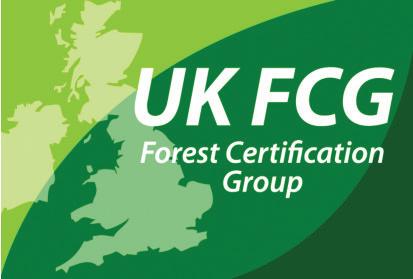



















































































































































































































































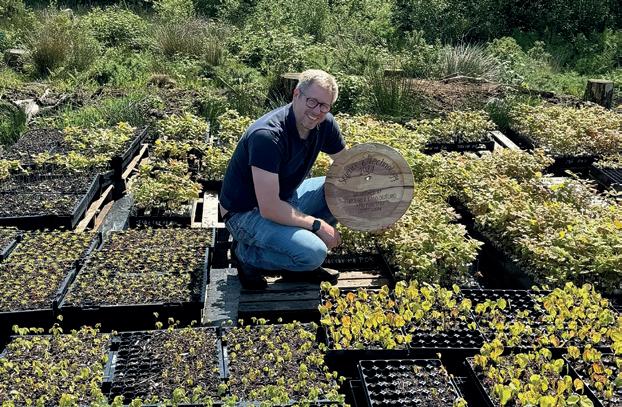
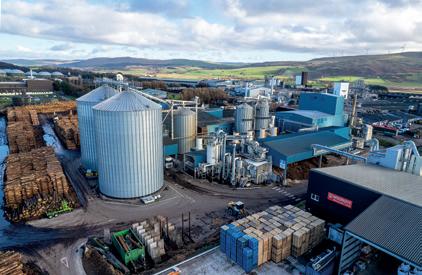
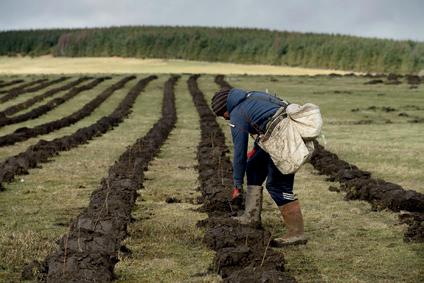
Andrew Bronwin presented with special award by Confor Chair Member update: We want to hear from you!
21 Trees and timber back on the agenda for the Royal Welsh Show 22 APF: Excitement grows ahead of the 2024 show
Confor Awards: A new path to putting down roots
Schools outreach programme provides vital STEM skills
New action to protect against impacts of bark beetle tree pest 32 Free help to central belt farmers to branch out into tree planting
54 STIHL GB opens new purpose-built head office in Surrey
55 Call for new houses in Ireland to be built with timber instead of concrete
56 £4m timber transport boost
57 World first as green RFID-tagged LOOP pallets enter UK sector

Big step forward in understanding the impact of biomass manufacturing
Unique course links tree growers with wood users
competition for commercial woodlands
Keeping your end of the bargain
it comes to insurance cover
sector mourns passing of Bill Mason
to

STUART GOODALL
CHIEF EXECUTIVE, CONFOR
Politics may not be everyone’s cup of tea, but who’s in power often has a significant impact on our industry.
When the Conservatives were elected in 2019 with a manifesto commitment to plant 30,000 ha a year across the UK, dozens of staff and hundreds of millions of pounds were allocated to delivering it.
Clearly, that hasn’t resulted in anything like what was promised, but the annual area is increasing, and we’ve seen significant public investment in forest nurseries and skills/recruitment. The government also worked with Confor to develop a Timber in Construction Roadmap and supported the National Wood Strategy for England.
At the time of writing, Labour looks set to win a majority in Westminster. Confor has spent time building relationships with key politicians in the party and we will at the very least be looking for a commitment to tree planting in their manifesto.
Your active support during the election will be important in achieving that objective. In this issue we are detailing the actions we want to see taken in England, as well as paths for you to get involved with political engagement at a local level. This is a UK election, and while the new government will make decisions that impact the whole UK, it’s
Confor is a membership organisation that promotes sustainable forestry and wood-using businesses. Confor members receive Forestry and Timber News for free as part of their membership. For more information on membership, visit www.confor.org.uk/join-us
Past issues and articles can be accessed online at www.confor.org.uk/news/ftn-magazine Non-member subscriptions: £75.07/(£80.85 overseas) Contact FTN@confor.org.uk
Forestry and Timber News is published by Countrywide Publications on behalf of Confor.
For advertising, contact Danny Lewis 01502 725858 danny.lewis@micropress.co.uk
greatest impact on forestry will be in England.
Of course, we should never rely on government to do everything, and to that end I’m very pleased to announce that Confor has established a subsidiary business: Forestry Training Service UK Ltd. This will aim to address market failure in the provision of technical training in specific areas critical to securing sustainable wood supply to the market.
The plan is that the company’s activities will be underwritten in its early years by major businesses in the sector, with support from the forestry agencies, as it recruits one to two members of staff and develops courses.
It is actions such as these, where Confor works with members to take the initiative, that we can have real impact, supporting the industry to be successful.
At the end of the day, however, we also have to recognise that the influence each government has on the industry in each nation is considerable, from regulation to grants, to standards for forest management and even carbon trading. At times that influence by government has been damaging to the industry, and it’s vital that we do everything we can to ensure that the new UK Government – of whatever political hue –works with us and not against us.

Stuart Goodall
Chief Executive T: 0131 240 1416 E: stuartg@confor.org.uk

Andy Leitch
Deputy Chief Executive M: 07881 510171
E: Andy.leitch@confor.org.uk


Printed by Micropress Printers Ltd

Eliza Hibbins-Cline Marketing eliza@confor.org.uk
Eleanor O’Neill
Communications Manager M: 07918 255930 E: eleanor.oneill@confor.org.uk

Richard Hunter
Technical and Industry
Support Manager 07867 379657 richard.hunter@confor.org.uk


John Bruce National Manager for England 07884 579215 john.bruce@confor.org.uk
April Armstrong
National Manager for Scotland M: 07780 190821 april.armstrong@confor.org.uk

Elaine Harrison Manager for Wales 356763 elaine.harrison@confor.org.uk
info@confor.org.uk
www.confor.org.uk
@forestsandwood on Twitter for news and updates

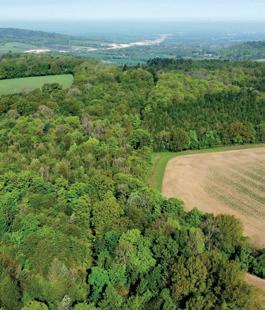



WOODLANDS AT THE LEE
Great Missenden, Bucks
For sale as a Whole or in 2 Lots
In All, 168.99 Acres / 68.39 Ha
Lot 1 Concord Wood 140.55 acres
Mid-rotation beech and oak. p2019 Douglas fir and other conifers. Excellent access
Guide price
£700,000
Lot 2 Lordling Wood 28.44 acres
Small Chilterns woodland with mixed age beech and oak.
Guide price £225,000
Guide for the Whole, £925,000
Sporting rights owned and included
WOOD
Near Ropley, Hampshire
30.08 Acres / 12.48 Ha
A well sized commercial woodland with good access. Stocked with several areas of p1960s, 1985 and 1990 productive conifers including pine and larch.
Shooting rights owned and included.
Hunting rights are excluded.
Guide price £275,000

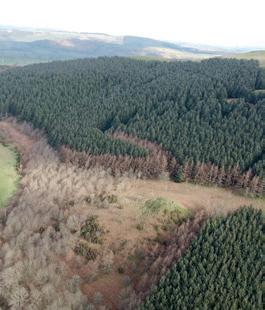
FFYNNON RHYS
Gorsgoch, Lampeter, Ceredigion
78.40 Acres / 31.73 Ha
Second rotation Sitka spruce, over half of which is ready for harvesting. Easy access.
Sporting rights owned and included.
Guide price £495,000

BRUCKTON & CHIPTON WOODS
Near Dartmouth, Devon
For sale as a Whole or in 2 lots
In All, 43.45 Acres / 17.58 Ha
Lot 1 Bruckton Wood 13.20 acres
mature Douglas fir and European larch, p2018 mixed broadleaves. Good access.
Guide price
£95,000
Lot 2 Chipton Wood 30.25 acres
Predominantly Douglas fir with naturally regenerated larch
Guide price 195,000
Guide for the Whole, £290,000
Sporting rights owned and included
HARROT HILL WOOD
Armaside, Cockermouth, Cumbria
63.43 Acres / 25.67 Ha
A maturing conifer wood situated in the Lake District National Park. Predominantly Sitka spruce with Douglas fir and Japanese larch. Good access. Sporting rights owned and included
Guide price £415,000


FFYNNON BADARN
Aberllefenni, Corris, Gwynedd
1189.44 Acres / 481.35 Ha
A highly commercial forest principally stocked with Sitka spruce planted over a period of almost two decades. Good access.
Sporting rights owned and included.
Guide price £7,800,000

LOGR facilitates real-time woodflow decisions and enhances transparency through tracking and traceability of woodfibre from forest of origin through to delivery.
Forestry, a dynamic supply chain with many stakeholders; including Landowners, Forest Managers, Harvesters, Hauliers and Processors (being local mills or ports to overseas markets).
Replacing the paper delivery note with an eDocket produced from a mobile app, connected to a cloud hosted service, allows for live insights, per load notifications and daily reporting. This data immediacy allows Stakeholders to better plan and adjust activities to ensure timely fulfilment of supply contracts.
LOGR, an Australian-based company with forestry industry clients across the world, provides a software suite to facilitate real-time insights across the supply chain.
“With growing institutional investment in natural capital assets like forestry and increasing regulatory scrutiny of use of land, such as EU Deforestation Regulation coming into effect from this December, the use of tools such as LOGR underpins Chain of Custody of wood products,” explained Craig Hull, LOGR Director, in citing the use of LOGR’s tools to track Euroforest’s supply of roundwood to James Jones & Sons’ Lockerbie Sawmill.
Craig went on to explain how a Euroforest Manager can define a new operation, configuring the product-todelivery combinations to a planned supply contract, document all applicable wood certification codes, assign the contractors performing the work, and GEO fence the forest operation.

Then using the LOGR app, hauliers with unique logins are automatically detected within the forest operation’s official geo-boundary ensuring only those with permission are able to perform an uplift. The app guides hauliers through a step-by-step docket wizard filtered with the parameters defined by the Euroforest Manager to create the eDocket.


With an eDocket record of the uplift performed and the delivery journey about to begin, notification of uplift is sent to the forest Landowner, and the inbound notice is sent to the Lockerbie Mill. GPS tracking of the eDocket from point of origin, on route, and arrival at delivery location, are recorded with universal timestamps, providing a traceable record on a per load basis.
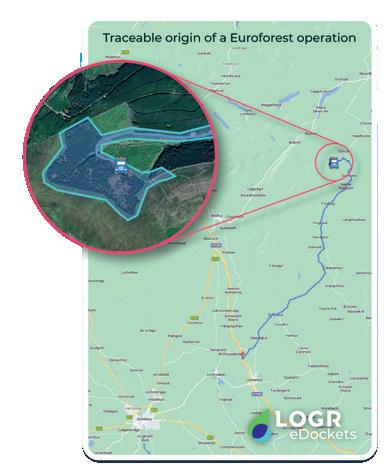
as receiver of the supply from Euroforest, along with their own weighbridge record, can produce periodic reports that their finished products were sourced from sustainable harvested logs with geo boundary and GPS detected positions as evident sourced from the LOGR eDocket.

Innovative delivery & weighing solutions
Digitising the delivery docket through the eDocket App opens additional opportunities for automation including real-time weighing integrations. Achieved through extensive R&D, the LOGR Edge device connects to existing indicator hardware of a weighbridge, to facilitate a smart wireless weighing process.
The LOGR Edge communicates with a weighbridge and wirelessly to the eDocket App combining load measurement weights, identity of the weighing truck, and load delivery (product) data, to produce a weighing receipt, which is processed locally and forwarded to the Cloud. Removing the need for the Haulier to exit their vehicle to interact with a weighbridge kiosk, or lightening the job of the weighbridge operator to process the transaction.
A cryptographically signed measurement receipt is reportable real-time via the Cloud, permitting the Receiver, Supplier and Haulier to each immediately access the digital synchronization between the eDocket and the reconciled delivery record.
Hereford-based Pontrilas Sawmills, with recent investment in Mill expansion,
LOGR UK are hosting a series of information sessions in late June and early July to share how their tools are being used in the UK industry. Find out about the latest product features and upcoming developments by signing up for an event in Scotland or Wales. www.logr.com.au/logr-uk
is looking to LOGR to improve woodflow into their Mill. With major suppliers of Pontrilas Harvesting, Euroforest and Bronwin & Abbey utilising LOGR eDockets and combined with the deliveries and weighbridge services of LOGR Edge, the Mill will streamline the weighing process.
Upon the truck entering the weighbridge LOGR Edge receives measurement readings from the indicator and after reaching a stable weight, the recognition camera is triggered to determine the registration plate number of the truck. With the weight measurement, and the truck identification in hand, Edge communicates with the LOGR Driver App to match with the corresponding eDocket.
After Driver confirmation, a synchronised weighing record of
product information and Gross weight is created. After unloading, a second weighing establishes the Tare and LOGR Edge completes the process producing a Net delivery record.
Craig emphasised the simplicity of LOGR’s innovation and design, stating: “Hauliers on behalf of Suppliers and their Customers have three decisions to make; upon being GPS detected in the forest they are asked ‘Where am I going?’ and ‘What product am I carrying?’. Then at delivery, when presented the weight measurement matched to the Driver’s load, ‘Did I receive a weight?’.”
Almost everything else can be automated through LOGR eDockets by administering the operations setup. LOGR will automatically generate the chain of custody information including Customer supply reference IDs, automatically obtain Pin Codes with State Forestry Commissions, and in real-time notify and report to connected Stakeholders the wirelessly synchronized weight measurements and delivery records.
Pontrilas Sawmill is currently undergoing final testing with the first trade loads measured through LOGR Edge scheduled for mid-late June 24.
Confor’s Policy & Public Affairs Officer, Jon Garson recounts the political atmosphere in the midst Election and sets out the priorities we are carrying into a new government.
We are experiencing a unique period where change is the mood of the day. Caught in the midst of an UK election, we have only recently had changes in First Minister leadership in Scotland and Wales. While this presents challenges it also holds the potential to be a significant inflection point for the sector.
At senior levels we hear strong messages of support across the UK. Whether it is meeting with Cabinet Secretaries, Ministers, or with senior officials, we hear the same message: how important the sector is, and how government wants to work with industry to provide certainty and to secure a prosperous industry for the benefit of communities across the UK.
This is supported by strong forestry strategies that all commit to increased planting and a robust industry.
Yet the reality we witness is often at odds with this mood music. Whether it is changes to the UK Forestry Standards, budget cuts or the seemingly annual failure for all nations to meet their planting targets, action too often has not matched the rhetoric.
At the same time, we have seen a strong focus across the country on the biodiversity crisis and nature restoration.

These government interests have narrative these expense focus discussions either/or forestry number include emissions, opportunity, deforestation, enhancing through benefits. requires needs of a Confor’s focus on forestry While and there “events, campaigns, that we in the polls in the House






wood-producing forests, and protect all existing forests.
Create a Timber Security Strategy: to a future level of sustained wood production that will see proportion of timber imports to the including from endangered overseas.
Promote Home-Grown Wood: target to significantly increase of new homes in England domestically sourced timber 2030. Utilise government’s power to make homegrown material of choice for all construction and renovation
Develop a Skills Action Plan: ensure these goals are met,
continued on page
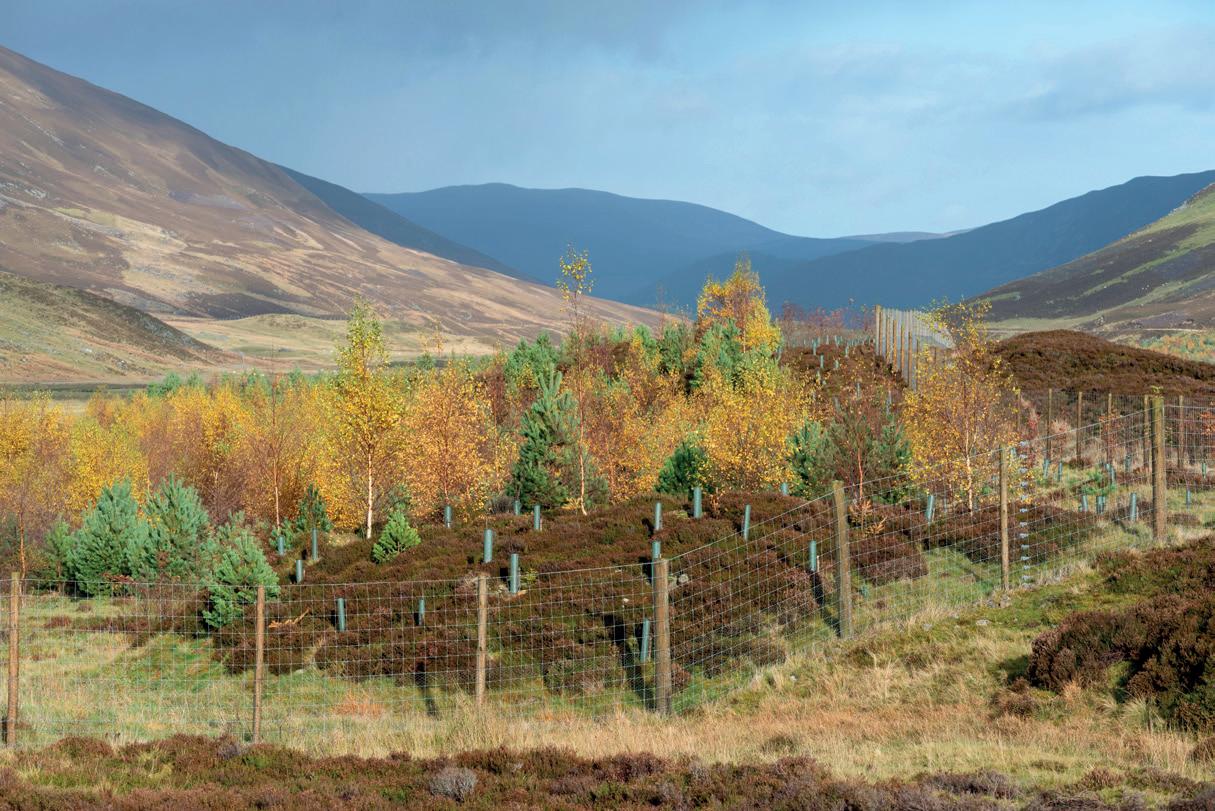
continued from page 9
implement a skills action plan in partnership with industry, to address workforce needs in the forestry and wood sector, including initiatives to help armed forces veterans enter the industry.
5Communicate the big messages: Surveys repeatedly show that people love trees, and wood products, but often don’t join up the two. A communications campaign should promote the importance of forests, timber security, and the economic and environmental benefits of the forestry and wood sector.
Unsurprisingly the election campaign so far has reflected the issues at the forefront of the public discourse: cost of living, state of the NHS, personal taxation and immigration.
This has resulted in manifestos that are somewhat lacklustre when it comes to a range of economic issues, including forestry.
A key theme of the election campaign has been the state of public finances. Indeed, the Institute for Fiscal Studies (IFS)
continued on page 12
The Woodland Trust and Confor are calling on all political parties to commit to urgent action to get tree planting back on track, with new investment and policy initiatives. Expanding tree cover is essential for tackling the climate and nature crises and providing vital sustainable economic growth. The minimum required by legal targets is 16.5% tree cover by 2050, but progress in recent years has fallen short of what is needed to meet that.
The Woodland Trust and Confor are also calling on the new government to protect existing woodlands from threats of pests, disease and climate change and to work with them to bring woodland into sustainable management. Only 7% of England’s valuable native woodland is currently in good condition. Urgent funding and
cooperation with the sector is needed to support the green jobs caring for the woods and forests we already have.
Confor Chief Executive Stuart Goodall said: “All political parties have supported greater tree planting, but we need to accelerate the rate of woodland creation in England. Momentum has been building in recent years, and it’s vital that the next government builds on that and commits the modest sums of money required to unlock huge benefits for jobs, the environment and tackling climate change.”
Dr Darren Moorcroft, Woodland Trust CEO, added: “We need all parties to set out plainly how they are going to meet tree targets, support green jobs and give nature a fighting chance for future generations. With the General Election looming, this is a pivotal moment for woods and trees. Woodland wildlife is still declining, irreplaceable habitats like ancient woods need urgent protection and restoration. Trees are one of the strongest weapons we have to tackle the nature and climate crises, so whoever forms the government after July 4th needs to act for people and the planet.”

Cashel Estate
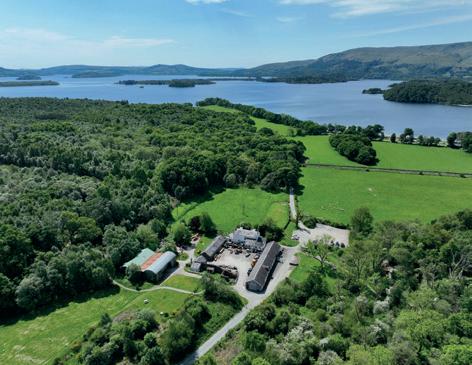

Loch Lomond & The Trossachs National Park 1,242 Hectares / 3,069 Acres
Loch Lomond & The Trossachs National Park 1,242 Hectares / 3,069 Acres
An exceedingly rare and desirable opportunity to purchase a stunning, wild Estate of international importance. Diverse natural capital assets, mixed ecosystems, biodiversity and carbon storage.
An exceedingly rare and desirable opportunity to purchase a stunning, wild Estate of international importance. Diverse natural capital assets, mixed ecosystems, biodiversity and carbon storage.
Sensational views west and south over the famous Loch Lomond.
Sensational views west and south over the famous Loch Lomond.
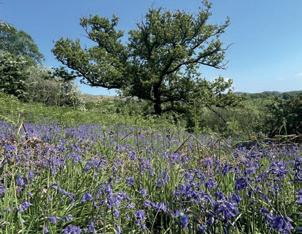
Loch Lomond & The Trossachs National Park 1,242 Hectares / 3,069 Acres
An exceedingly rare and desirable opportunity to purchase a stunning, wild Estate of international importance. Diverse natural capital assets, mixed ecosystems, biodiversity and carbon storage. Sensational views west and south over the famous Loch Lomond.
Freehold For Sale as a Whole or in Five Lots.
Freehold For Sale as a Whole or in Five Lots.
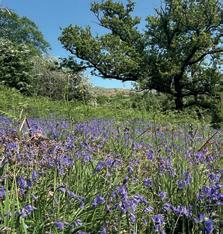

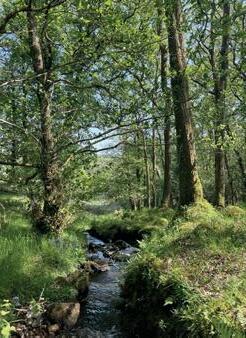
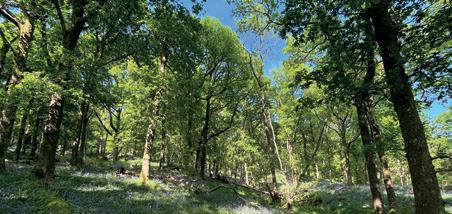
Freehold For Sale as a Whole or in Five Lots.
Offers Over £ 4,085,000
Offers Over £ 4,085,000
Offers Over £4,085,000
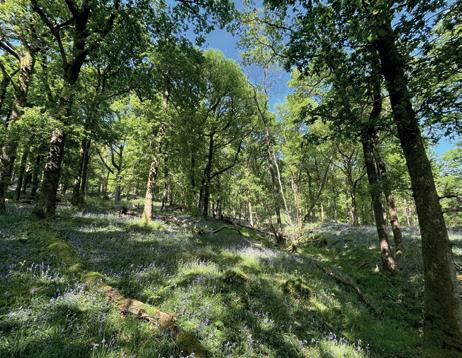
Jon Lambert MRICS jon@goldcrestlfg.com 07900 320 475
Jon Lambert MRICS jon@goldcrestlfg.com 07900 320 475
18 Great Stuart Street Edinburgh, EH3 7TN +44 (0) 131 3786 122 | E: office@goldcrestlfg.com | W: www.goldcrestlfg.co.uk
Jock Galbraith MRICS jock@goldcrestlfg.com 07951 177 323
Jock Galbraith MRICS jock@goldcrestlfg.com 07951 177 323
18 Great Stuart Street Edinburgh, EH3 7TN +44 (0) 131 3786 122 | E: office@goldcrestlfg.com | W: www.goldcrestlfg.co.uk jon@goldcrestlfg.com 07900 320 475 jock@goldcrestlfg.com 07951 177 323


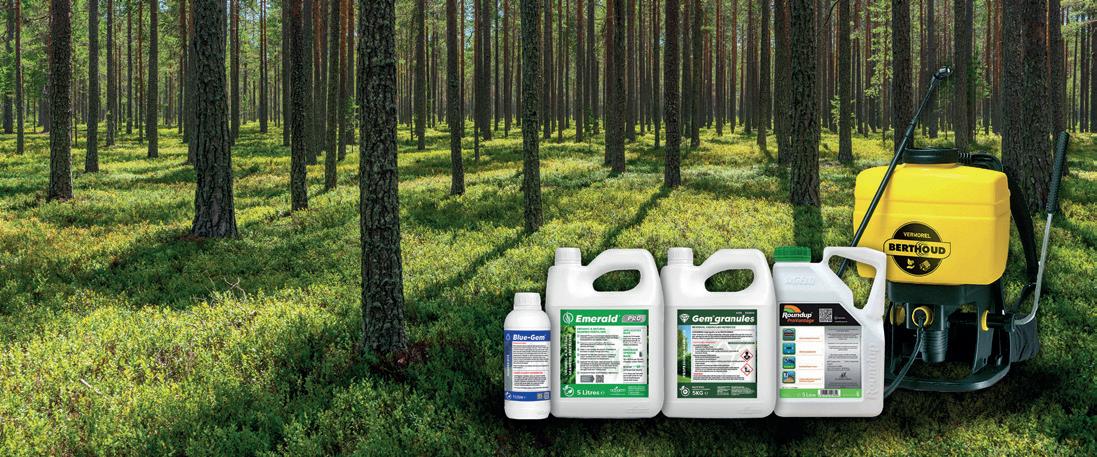
Cashel Estate
Loch Lomond & The Trossachs National Park 1,242 Hectares / 3,069 Acres
An exceedingly rare and desirable opportunity to purchase a stunning, wild Estate of international importance. Diverse natural capital assets, mixed ecosystems, biodiversity and carbon storage.
Sensational views west and south over the famous Loch Lomond.
Freehold For Sale as a Whole or in Five Lots. Offers Over £ 4,085,000
18 Great Stuart Street Edinburgh, EH3 7TN +44 (0) 131 3786 122 | E:
“Elections are always a time for change and present an opportunity for sectors to reset their relationship with government.”
continued from page 10
says the topic hangs over the election campaign “like a dark cloud”.
This has led to both the Conservatives and Labour trying to outdo themselves on their fiscal prudence and responsibility. Both have committed to getting debt down, adhering to self-imposed rules on borrowing and public spending.
When combined with election commitments to not raise the primary taxation mechanisms (and to reducing some of them in the case of the Conservatives), it is clear that the defining goal of any new government will be a review of public finances with a goal of finding a way to make positive change from the fiscal box they have placed themselves in.
This will consume government’s focus and resources for some time postelection. This is demonstrated by the announcement of Labour’s ‘first steps for change’:
1. Delivering economic stability
2. Cut NHS waiting times
3. Launch a new Border Security Command
4. Set up Great British Energy
5. Crack down on antisocial behaviour

6. Recruit 6,500 new teachers
This challenge is further reflected in the respective manifestos with forestry not featuring heavily and only mild and vague commitments to tree planting. All parties have positive statements regarding the need for new tree planting, but neither of the two main parties have included targets or specific numbers.
However, Labour’s platform does present some opportunities for us to engage. While not a manifesto commitment during the campaign, Labour have confirmed their intention to establish a Tree Planting Taskforce. The make-up of this group and its mandate and scope are unclear, but Confor and the productive sector will engage to ensure we are a key component of this group and its work.
A further avenue we will be working towards influencing is the manifesto commitment to “a new partnership with business to boost growth everywhere”. This will include a new industrial strategy
and the establishment of an Industry Strategy Council.
One of our sector’s key strengths is the economic opportunities and jobs in areas that have few other options for creating new economic growth. We will utilise the new structures and processes to enhance the role of forestry and wood use in the national economy.
To influence the new government and to raise the profile of the benefits and opportunities of the sector will require a collective effort from members across the country. While Confor will work to engage senior government leaders we will also need to engage elected officials at the local level, primarily through you as business leaders in local communities.
It is always important to engage MPs in their constituencies, but this will be particularly important post-2024 election given the level of change we will see in MPs being returned to Westminster.
As mentioned, the polls are indicating
a sizeable Labour majority which will mean a large number of new Labour MPs. In addition to this we have also seen 131 current MPs indicating they will not be running in the 2024 UK General Election. Many members will also see a change in representation as a result of a 2023 Boundary Commission report, which has resulted in significant boundary changes for this election.
Elections are always a time for change and present an opportunity for sectors to reset their relationship with government. All indications are that the 2024 general election will represent a fundamental change in government.
It is crucial that as a sector we are coordinated in our approach and messaging to elected officials. Confor will be stepping up its political engagement and will be looking to work with members to enhance these efforts to ensure that your local issues are enhanced by feeding into a national narrative about the importance of forestry.
https://bit.ly/ConforGE24












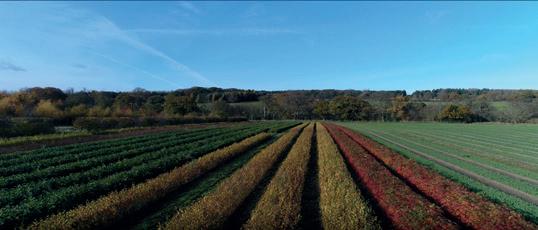
Superior planting stock for commercial forestry. Specialist grower of northern UK and Scottish seed zone provenances to suit all planting requirements
We are situated in the beautiful county of Northumberland and supply around 15 million bareroot conifer and broadleaf trees per year to a wide customer base. A Plant Healthy accredited grower of major native timber and woodland species including improved Sitka Spruce. Trees can be pre -treated against Pine Weevil if required.
Our team have over 200 collective years experience in growing and nursery production as well as a firm understanding of the forestry industry. Our cold storage facilities ensure our trees are stored at the optimum temperature until you need them. Please get in touch today. No query is too big or small.
TreesPlease Ltd, Dilston Haugh Farm, Corbridge, Northumberland NE45 5QY 01434 633049 sales@treesplease.co.uk www.treesplease.co.uk













The Agriculture and Rural Communities (Scotland) Bill, which was passed into law on 18th June, was intended to be a means for the Scottish Government to develop a support framework for Scottish Agriculture following Brexit and our subsequent exit from the Common Agriculture Policy. It was also presented as the mechanism for the Scottish Government to deliver its Vision for Agriculture.
However, a number of MSPs sought to use the Parliament’s consideration of the Bill as an opportunity to force changes, including on forestry. In response, Confor prepared briefings for MSPs setting out why the proposed forestry amendments should be reject-ed. In the end the proposed amendments that were of concern to Confor were either withdrawn due to insufficient support or were not approved by MSPs.
We were concerned that the Bill is ‘framework’ legislation - this means that the detail is established through
regulation or secondary legislation. The Bill also includes a re-quirement for the government to develop a Rural Support Plan.
We highlighted the lack of specificity in our submission during the initial consultation and expressed concern that for an industry like forestry which requires certainty and confidence this presents a significant challenge.
As the process continued several parties used the proposed legislation to attempt to introduce additional measures to the Bill. Of particular concern were several amend-ments directed at forestry. One would have required public consultation and communi-ty engagement with ‘affected’ communities for every proposed forestry scheme, but lacked robust guidance and criteria on what constitutes community engagement for all parties (and who constitutes the community). Another proposed amendment was that all forestry projects over 40 hectares would require, by law, an Environmental Impact As-sessment (this was later amended to over 50 hectares).
Confor engaged immediately on these proposed amendments which were debated by the Rural Affairs and Islands Committee. Confor outlined our concerns in a briefing note to all committee members. We followed this up with targeted communication to key members of the committee and to the Cabinet Secretary’s office. This resulted in none of these proposed amendments being supported by the committee. We continued to monitor the situation and noted that variations of these amendments were being tabled again
during the final stage of the legislative process. In addition, a further amendment which required that restocking on productive forests be restricted to food producing trees was also introduced.
The final stage, involving all MSPs, ends with a final binding vote on the legislation so we developed a further brief outlining our concerns and our opposition to these amend-ments and sent them to every MSP.
We were pleased to see that in the debate Confor was recognised by speakers in the Chamber as they utilised our material to express their concern. In the end none of the proposed amendments were approved.
While people familiar with the sector would have recognised the challenge presented to the sector it is worth noting that many MSPs have limited experience of forestry. While the majority of MSPs respond to the reasoned arguments put forward by Confor, unfor-tunately, this is not the case with all. In this instance, Scottish Labour supported one of the Green Party amendments that would have damaged efforts to create more woodland in Scotland
As is always the case with new legislation, particularly when the Bill is framework legisla-tion, this is only the beginning of the process. We will need to monitor a range of issues for their impact and potential unintended consequences.
Most importantly Confor will be active in the development of the Rural Support Plan. We will actively engage members in this important process to ensure the importance of for-estry is reflected in the process and outcomes of the plans.



The Scottish Timber Trade Association (STTA) brought the timber industry together at Holyrood for the first time in April to host a reception about driving Net Zero awareness and timber’s benefits to the Scottish economy.
Along with three other leading timber organisations, Confor, Timber Development UK, and the Structural Timber Association (STA), the STTA invited more than 40 businesses operating in the timber industry supply chain across Scotland to meet with MSPs and discuss timber’s role in the Scottish
The reception was sponsored by Fergus Ewing MSP and Willie Rennie MSP, who each spoke about the benefits of timber as a low-carbon construction product; how timber planting, processing, and use in construction creates skilled career opportunities and supports employment in rural areas; and how
of the industry.
Alex Goodfellow, CEO of Offsite at the Fife-headquartered Donaldson Group and STA board member, also spoke about Scotland’s need to increase the production of timber as global demand grows, and to preserve jobs for the future.

Scotland’s timber Industry contributes more than £1bn to the Scottish economy per year through homegrown product alone, and it directly supports 8.7% of the entire Scottish workforce, with 13.7% of all Scottish businesses directly involved in construction.
Speaking about the event, Alex Goodfellow said: “The reception was the first time the timber industry has gathered at Holyrood to discuss sustainability and how timber in construction supports the drive to Net Zero. Scotland excels at timber production, and we lead the UK in the use of timber frame construction, both of which support the country’s economy and sustainability goals. However, more production is needed.
“Global demand for timber is increasing and we predict that based on current production levels, we will be fighting for product by 2050. There is ample scope for increasing productive

woodland in Scotland and especially as we promote increased use of timber across the rest of the UK, we have a great opportunity to further support the Scottish economy through the supply of this low carbon construction product.”
Crawford Churchill, STTA President, said: “As timber is increasingly recognised for its structural applications as well as its sustainability, it is important that we continue to advocate for both its production and its use in Scotland. As a low embodied carbon material that can be repaired, reused, and recycled, it has a vital role to play in construction here and across the UK. Bringing the industry together with policymakers at Holyrood in an important step in this process.”
Mr. Fergus Ewing MSP said: “The timber trade sector does a great job for Scotland and is vitally important. We must substantially increase productive timber plantings and see timber used more in construction here and south of the border. We should work cooperatively with the UK Government on this endeavour. This meeting is a great chance to meet key players, hear their ideas and help MSPs understand how important is the work STTA members do.”
Mr. Wille Rennie MSP said: “This is an opportunity for parliamentarians to fully understand this important sector, what makes it a success and what government needs to do to allow it to make an even larger contribution to jobs and the economy. There’s been much talk about tree planting from ministers to tackle climate change and biodiversity which is right, but we also need to understand that for construction purposes we also need to plant the right type of trees in the right numbers and ensure the supply chain and sector is working effectively.”
Toby Perkins MP, Labour shadow minister with responsibility for forestry, saw for himself the scale of the industry on a visit to Egger at Hexham.
Business leaders from nurseries, sawmills and panel board manufacturers gathered at the Egger manufacturing site in Hexam to greet Toby Perkins MP and local Labour candidate Joe Morris last month.
Organised by Confor, the visit and meeting provided the opportunity to impress upon the shadow minister the significance of the industry to areas like the far north of England and to discuss the importance of future wood supply for future investment, including through woodland creation.
“Toby has taken a real interest in the industry,” said Confor CEO Stuart Goodall. “He can see that when businesses in the sector have
confidence in the future, they have a track record of investing hundreds of millions of pounds in areas like Northumberland and Cumbria, securing and creating thousands of jobs.”
As well as a tour of the impressive Egger facility, Mr Perkins discussed issues of timber security, the reliance of the bulk of the industry on softwood, and the benefit of using more homegrown wood, especially in house building and construction.
Representatives from Trees Please, Gresham House, AW Jenkinson, Tilhill, Scottish Woodlands, James Jones & Sons, Glennon Brothers, Euroforest, A&J Scott and the Wood Panel Industries Federation were in attendance.
The discussion also ranged across recruiting new people into the industry, including diversifying the workforce, training, opportunities for farmers to create new productive woodland and the importance of woodland creation of fast-growing trees for net zero.
Reflecting on next steps, Stuart added: “We hope to take Toby out to see forestry at work in southern England where issues like squirrel and deer control are particularly important and maintain a dialogue with the Labour Party.
“There is only a small team in Confor to represent the sector across the UK, so I was very grateful that so many members gave their time to meet with Toby, and that Alastair Kerr of the Wood Panel Industry Federation was able to join us.
“There is a lot of work to do ahead of the General Election and active member support will be vital.”
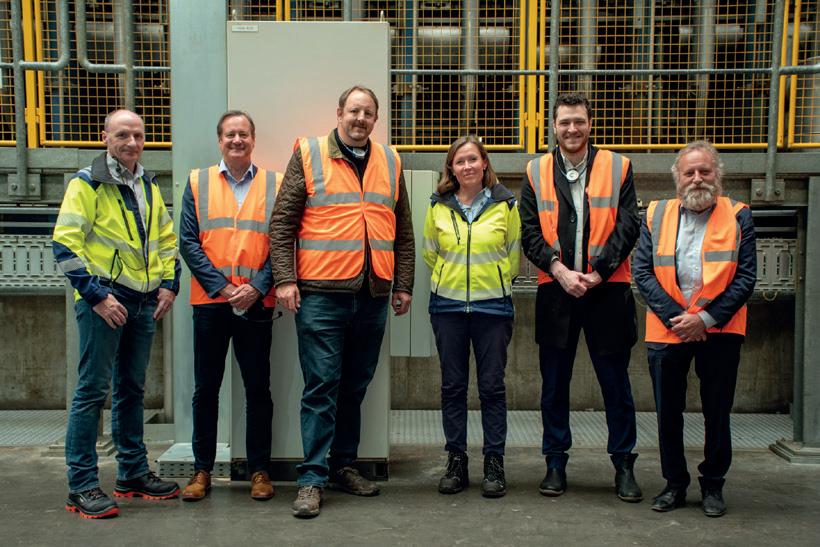
But there’s more to be done, reports David Lee
Woodland creation in the UK has reached modern-day high, but governments across the UK have been urged by Confor to push harder - to meet the Climate Change Committee’s recommended target of 30,000 hectares per year and tackle the growing challenge of timber security.
Official Forest Research statistics, published on 20th June, showed that 20,660 hectares of new woodland was created in the UK in the 2023/24 planting period - up from just 12,960 hectares in 2022-23.
The biggest rise came in Scotland, where just over 15,000 hectares of new woodland were created (up from 8,190 in 2022-23) - with a strong conifer component of 8,720 hectares.
England showed an increase, from 3,130 to 4,550 hectares, and there were 640 hectares planted in Wales (compared to 1190 in 2022-23) and 430 hectares in Northern Ireland (450 in 2022-23).
The 20,666-hectare total is the highest woodland creation figure for a generation, although still short of the Climate Change Committee’s recommendation of 30,000 hectares to be planted in the UK annually.
Confor’s Chief Executive Stuart Goodall said: “These figures are encouraging news for our industry and for the UK’s economy and environment and give the next UK Government a good base to build on to take us up to 30,000 hectares a year.
“There are still some fundamental issues that must be addressed - especially the lack of wood-producing forests created in England, Wales and Northern Ireland [less than 500 hectares in total]. And we need ministers and the forestry agencies to be more vocal about the need for, and benefits of, large-scale productive planting, for the UK’s future timber security, for investment and jobs, and to achieve net zero.
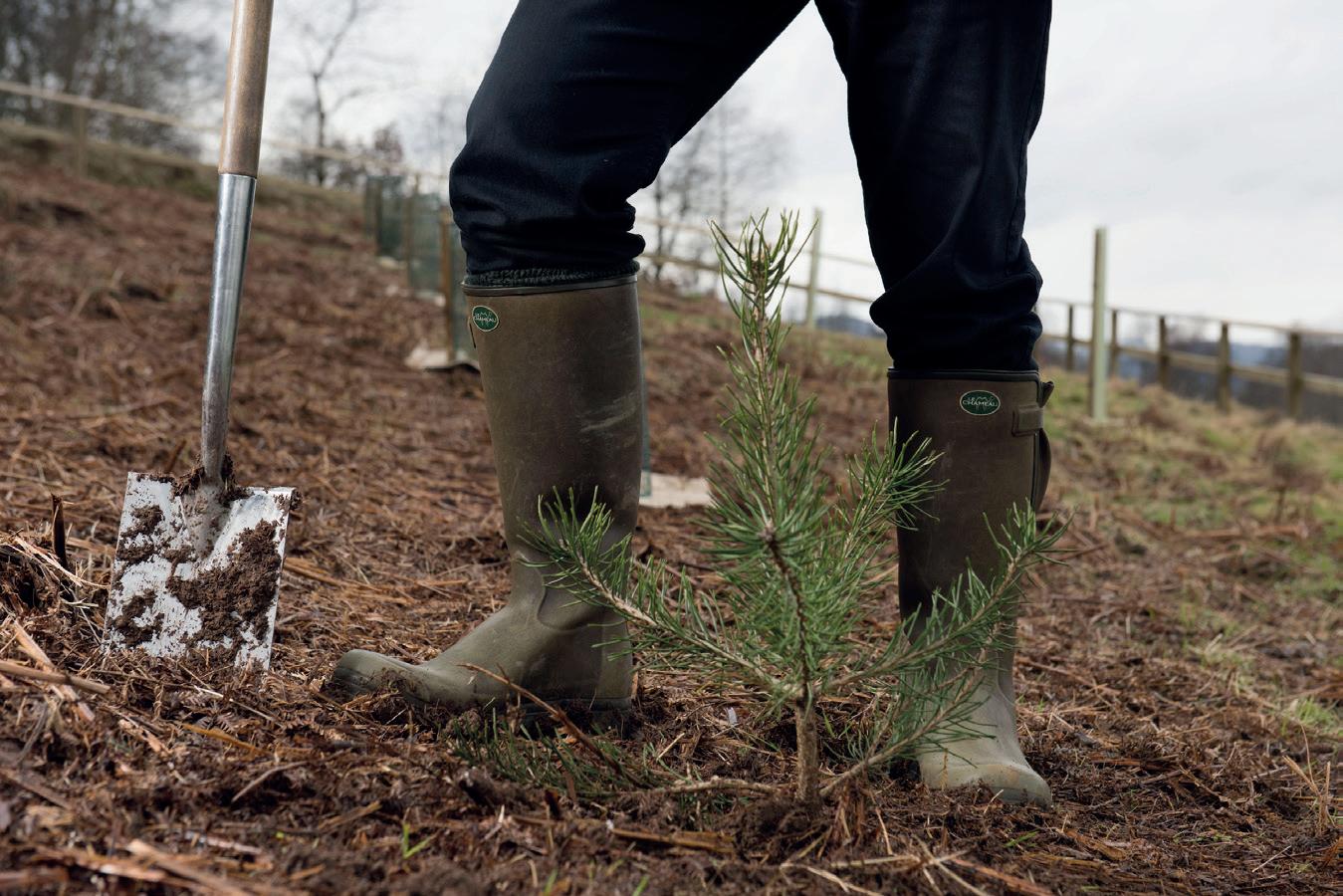
soars, so we have a responsibility to grow far more of the wood we use. That means planting more conifer forests – which will also help in meeting climate change targets because fast-growing conifer species soak up carbon more quickly.”
“As well as protecting the existing vital resource of timber, we need more wood-producing forests across the UK to provide the timber the country badly needs. Global timber demand is soaring as the world chooses to use more wood to build, instead of concrete, brick and steel. The UK needs much more home-grown wood to build the new homes all the main parties recognise we need - to make some inroads into the 81% of wood used in the UK which is currently imported.
“This can’t continue as global demand
John Bruce, Confor’s National Manager for England, said the England figures were positive, and reflected crucial work behind the scenes to streamline the consultation process for new planting applications and improve the funding package offered by the England Woodland Creation Offer (EWCO).
He added: “Funding is being targeted specifically to encourage EWCO applications on low sensitivity land, avoiding land most suitable for food production. This gives landowners and growers more certainty that new planting projects will happen on these lowsensitivity areas that have been mapped
out by the Forestry Commission.
“The way the funding is structured aims to encourage larger schemes, which can take longer to complete. Although the figures on wood-producing forests this year might look a little disappointing to some, I think we will see a clear pick-up in 2024-25.”
Mr Bruce said there was still room for improvement in the “complex and timeconsuming” application process and in balancing competing land use interests.
“While we recognise the importance of bird surveys and protecting habitats, it’s important that the UK Government also recognises the importance of long-term timber security and plants more woodproducing forests.”
Confor has set out a 5-point plan on how an incoming UK Government can boost tree planting and wood use in its 2024 election manifesto.

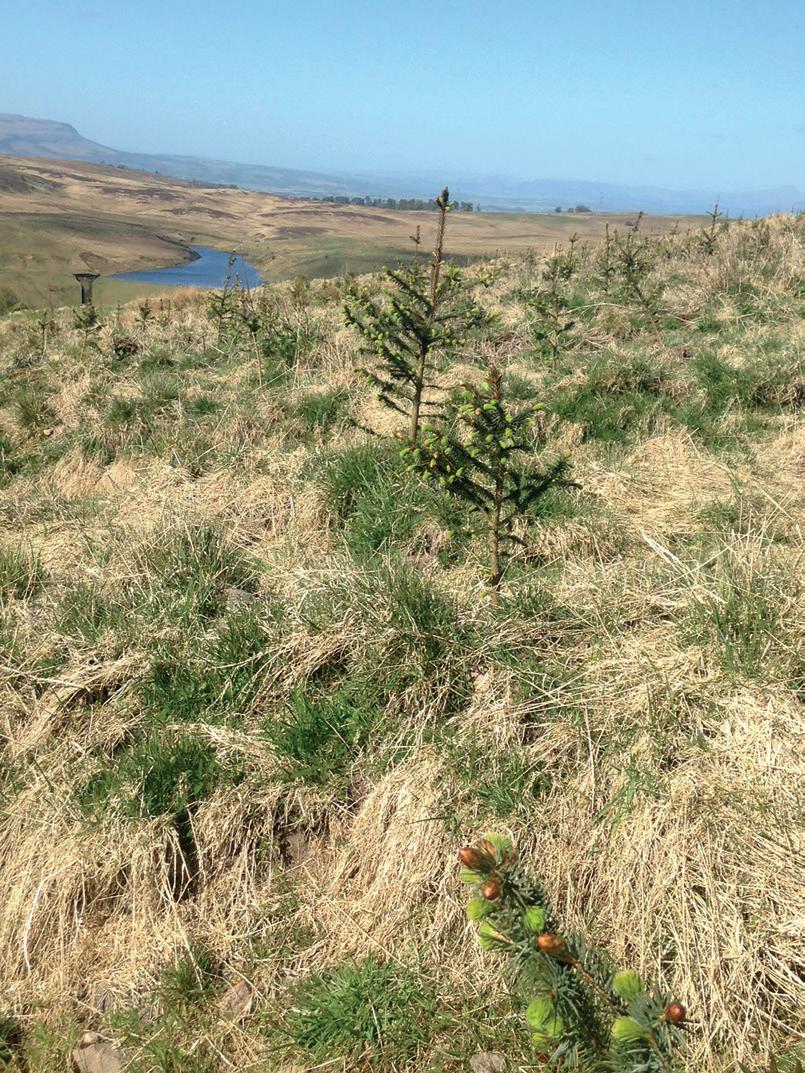
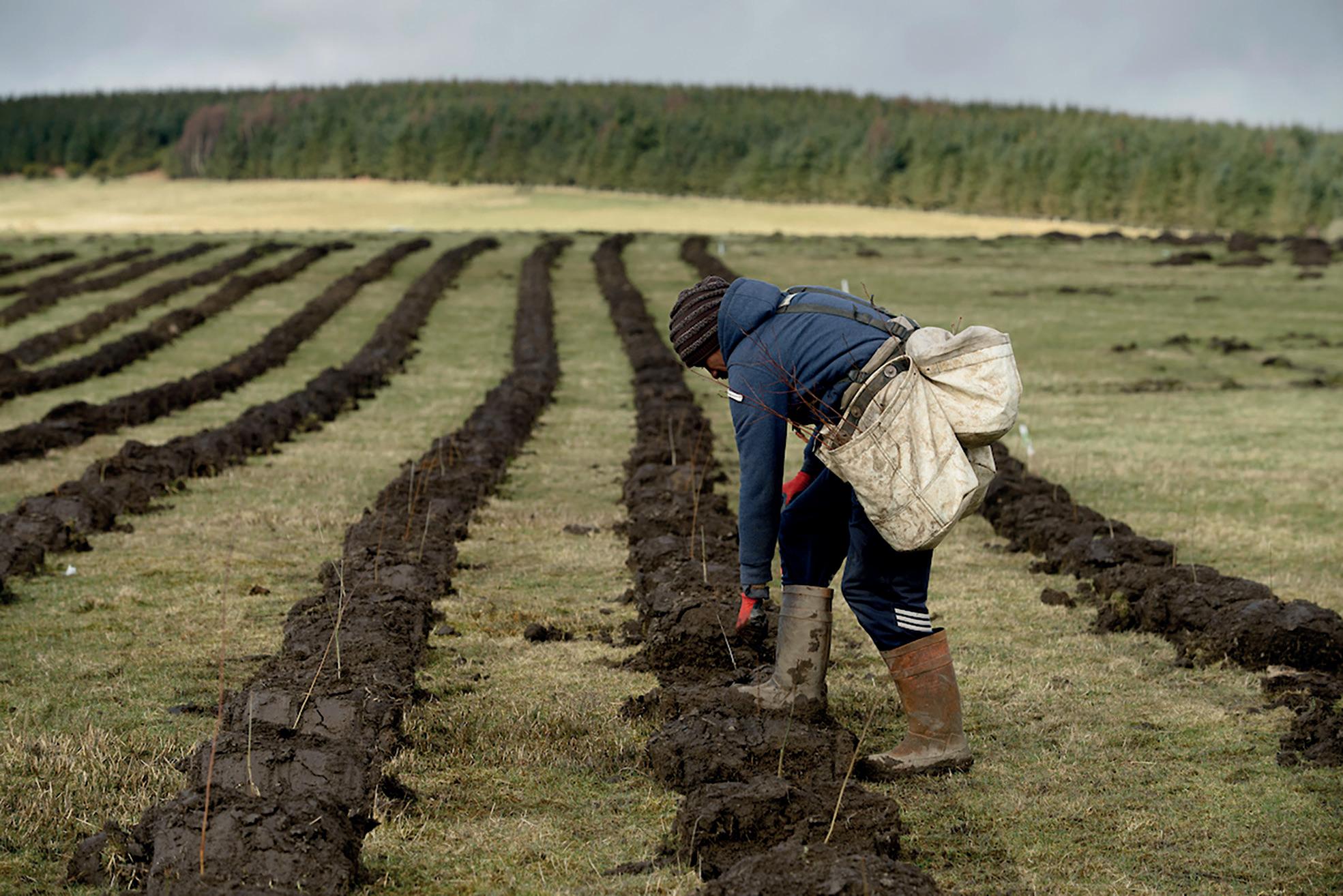
The 15,000+ hectares planted in Scotland in 2023-24 is a modern-day high - exceeding the 11,210 hectares planted in 2018-19.
However, the figures come at the end of a turbulent year. After disappointing planting figures in 2022-23 (8,190 hectares), the Scottish Government announced a forestry summit to regain momentum.
Cabinet Secretary for Rural Affairs, Mairi Gougeon MSP, convened the summit in December 2023, but just days later, the Scottish Government announced a cut of more than 40% in its woodland creation budget for 2024-25.
After industry pressure, the window
for planting in 2023-24 was extended from the end of March until mid-May, allowing schemes to be funded under the existing budget.
The 15,000-hectare figure announced today includes 8720 hectares of conifer planting, which is crucial to provide the future timber Scotland and the wider UK needs.
Mr Goodall said: “These figures are bitter-sweet. It is an impressive performance from the forestry sector, both private and public, but it comes after the Scottish Government has taken an axe to the grants available for woodland creation next year. Surely, having seen what can be achieved when the private and public sector
work together towards a common goal, the Scottish Government has to respond and find the additional funds required to secure a similarly strong performance next year.
“Let’s build on the growth in planting this year. With clarity on increased future funding, our nurseries will plant the young trees we need.
“If we don’t get a clear commitment to increased future funding, the boom of 2023-24 could lead straight to bust - and that would be hugely damaging for Scotland’s rural economy and environment. In light of the new planting statistics, I’m calling on the Scottish Government to take the right path.”
Ahead of his retirement later this year, Andrew Bronwin has received an award for Dedicated Service to Forestry in Wales from Confor.
Andrew Bronwin, Co-Founder of Bronwin & Abbey and former Confor Chair for Wales, will soon be retiring from the sector after over 35 years managing woodlands throughout the UK.
As well as providing his clients with professional, high quality service, Andrew has given his time to serving the wider industry in Wales.
Speaking at a dinner for the Confor Advisory Board, Confor CEO Stuart Goodall said: “In his time, Andrew has served as chair of the Wales Forest Business Partnership, ICF Wales and Confor in Wales.
“Reading through a number of client testimonials to Andrew a few things jump out – Andrew is described as the ‘go to’ man for forestry estates and “an outstanding and trusted advisor”. He is also described as someone “you can have a really good row with and remain the best of friends… and also maintain the greatest respect”.
“Perhaps the best way of summing up Andrew’s career is this commentAndrew’s “legacy will be a client base that has followed his advice and will be seen in the quality of their woodlands
and forests in decades to come”.”
Lord Ian Duncan, Confor Chair, presented the special award Service to Forestry in Wales
Andrew began his educational with a degree in rural land management at Reading then, combined with to Scotland, he completed a in agriculture and an MSc in Natural Resource Management.
Andrew’s career started in highlands of Papua New Guinea early 80s as a VSO volunteer agriculture. Prior to that he had with single homeless people a few years. He then worked Tilhill before setting up Andrew & Co. in 1996.
This business merged with Forestry in 2021 to form Bronwin and offer forestry management throughout the UK, with a focus the Marches and Midlands.
Rob South, Operations Director Bronwin & Abbey, said: “It has pleasure to develop as a forester a person with such passion for and strong moral compass, and proud to be following, all be his footsteps.”
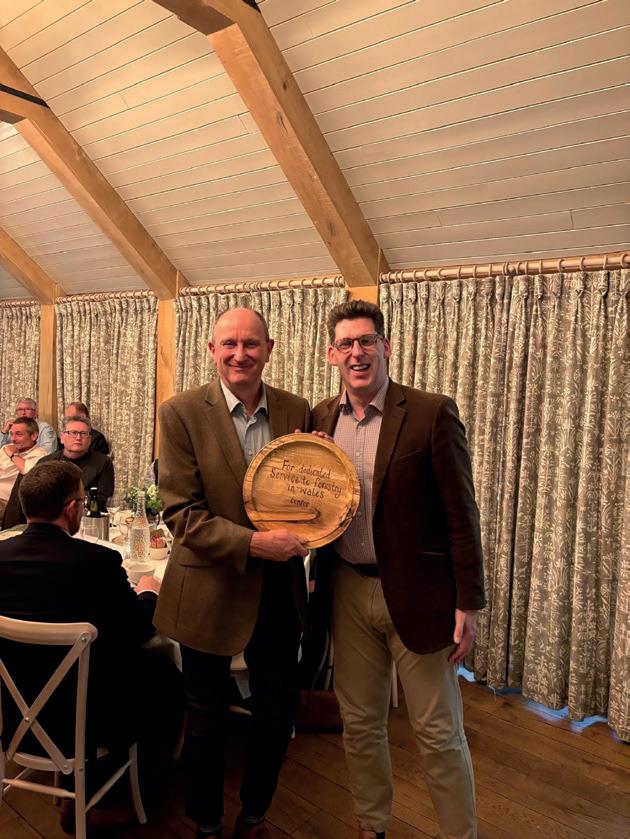

Eliza Hibbins-Cline, Membership & Marketing Manager
Anote from me to remind you that your support to Confor is SO vital to the future of the forestry industry, especially in the times we are seeing now with the upcoming election.
We want to make sure you get the most out of your Membership with us; for any comments or improvements you think we should make, please complete our feedback survey (https://bit.ly/4bcGLe6) or email me directly at eliza@confor.org. uk. We welcome your thoughts so please don’t hesitate to share!
For those of you who will be attending
the Royal Welsh Show 2024, I very much look forward to seeing you all there. We will be in a new spot compared to previous years so make sure to come and find us to say hi!
It’s still a few months away but we’re already getting enquiries about attending APF 2024 – remember that Confor members enjoy free entry to the showground and discounts on exhibitor places! We will be sending out copies of your membership cards to everyone in August so you can present proof of membership at the gate. If you are interested in sponsorship opportunities within the APF Confor Seminar tent, please contact john.bruce@ confor.org.uk for more information.
Finally, some exciting news! Confor’s head office will be moving to a new address in late July. We’re staying in Edin-
burgh but leaving George Street behind. It’s truly the end of an era but the team couldn’t be more excited to collaborate and provide your continued services from a new space. Updated mailing details to follow – please contact me with any further queries.
A warm welcome to our newest members: Wales: J Thomas farms and forestry, Tirwedd Sustainable Garden and Tree Services LLP. Scotland: Peter Graham & Associates, Scotfell Ltd. Northern Ireland: IndiWoods Ltd & Crookedstone Conservation. England: Underpine Woods, WildTrackPro, Vigilis Tree Shelters Ltd, Alfanar Energy Ltd, Maydencroft Ltd, The Birmingham Institute of Forest Research and Lily McGuiness. International: Margules Groome Consulting B.V.
Contact Eliza on 07918 880285 or email eliza@confor.org.uk

The Confor Business Hub will be returning to the Royal Welsh Show 2024 with support and representation from across the sector.
This year’s forestry industry expo will bring together new and familiar faces alike, including Pryor & Rickett Silviculture, SAF Woodlands, the Institute of Chartered Foresters, Euroforest Ltd, Pontrilas, Bronwin & Abbey, and Focus on Forestry First.
Elaine Harrison, Confor National Manager for Wales, said: “I am delighted to be taking the helm for Confor’s Hub at the Royal Welsh this year. Incredible work has been done to raise the profile of forestry at the Show and that is reflected in the huge interest we have received for 2024.
“I would like to thank our sponsors, without whom hosting the Hub would not be meeting issues successful
Please drop by needs some hospitality.



Monday 22 July
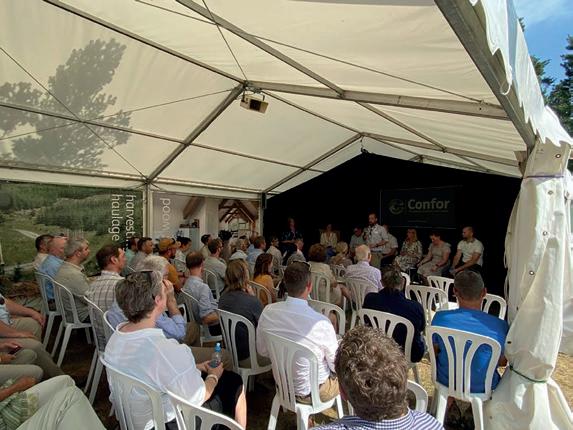
11:15: Ash dieback – What is it and what do you do?
12:00: Forest Research
13:00: What is a felling licence and how do I sell my timber?
Tuesday 23 July
9:30: Foresters’ Breakfast (Sponsored by MWMAC, FCA & Iwan Merion Forestry)
10:30: Forest Research
11:15: Management of small woodlands and interventions, Institute of Chartered Foresters
12:00: Increasing timber value: Wood Gary Newman by Bronwin
Wednesday 24 July
9-11.00: CLA Tent: Confor are hosting a breakfast Pannel Discussion: Rural land use & the future of trees (Sponsored by the Velcourt Group)
10:30: Forest Research
11:15: What is a felling licence and how do I sell my timber?
12:00: Ash dieback – What is it and what do you do?
13:00: Trees on farms, Farming Connect and Tilhill
Thursday 25 July
10:30: Managing grey squirrels, Squirrel Accord
11:15: RWAS Schools Competition 12:00: FISA Q&A
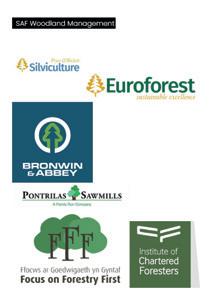
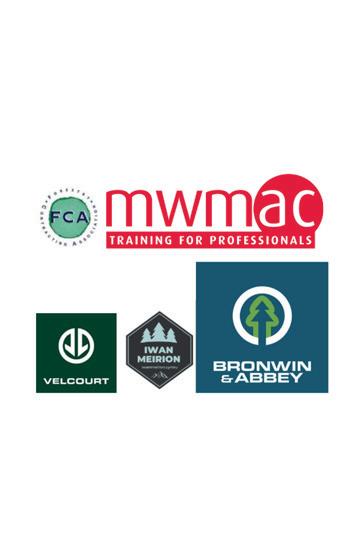
Industry Strategy Government
A big thanks to all our sponsors: Sponsors: Bronwin & Abbey; Velcourt Group; MWMAC, FCA and Iwan Merion Forestry. Business Hub: Institute of
13:00: Wood is a high-tech material, Bio Composites Centre Bangor
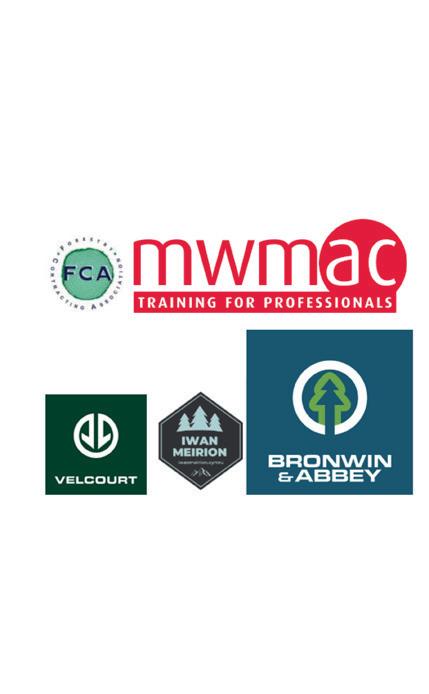
Chartered Foresters; SAF Woodlands; Pryor & Ricket Silviculture; Euroforest Ltd; Pontrilas; Bronwin & Abbey and Focus on Forestry First.
SPONSORS BUSINESS HUB

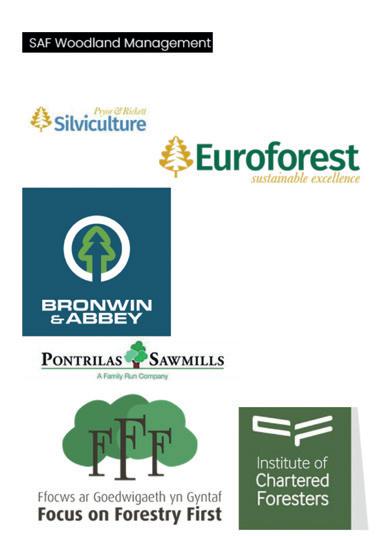



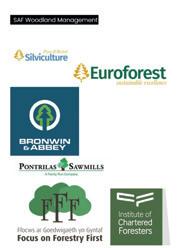

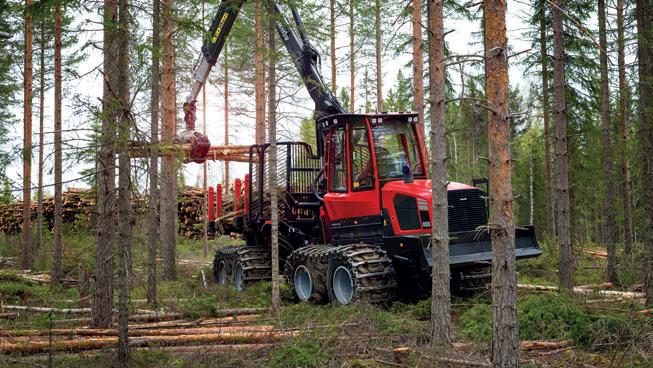
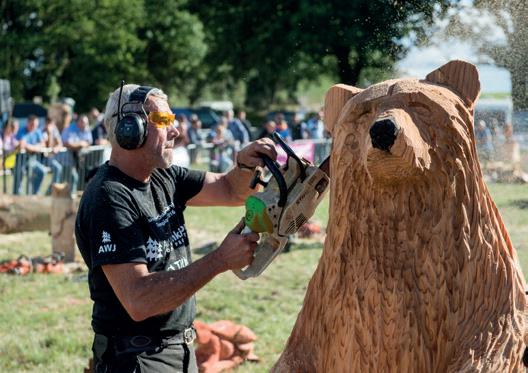
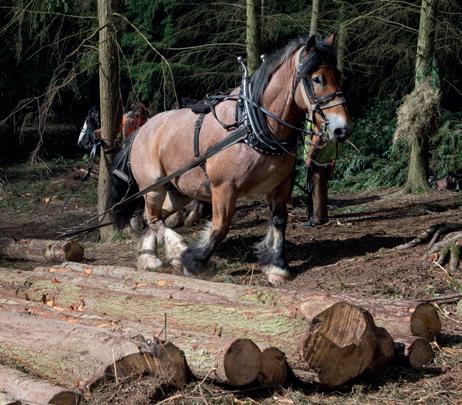
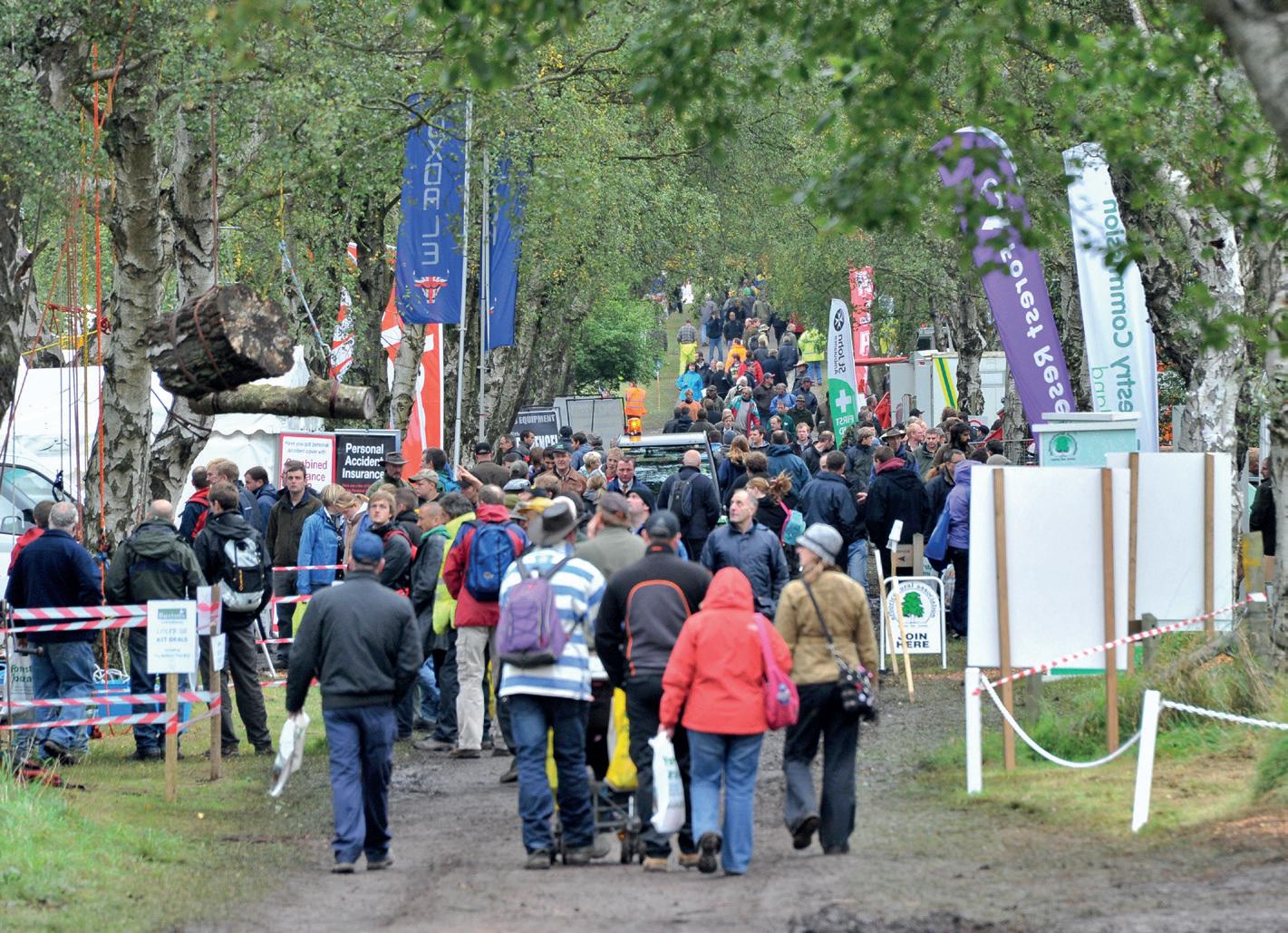
APF Exhibition Secretary Ian Millward brings us up to date with the huge range of events and competitions taking place at this year’s show
APF 2024 seems to be rushing towards us and the amount of work for the Demo Committee seems never ending. For myself the familiar tingle of excitement grows as I look forward to another show even after 30 years as Exhibition Secretary!
Exhibitor bookings continue to flood in, and the demonstration circuit is now 95% booked a - it will almost certainly sell out before the show. We recently welcomed Komatsu Forest as our 230th exhibitor.
The Fencing Village which we introduced as a ‘show within a show’ at APF 2018 has continued to grow and we have had to expand the area to cope
with the level of bookings received. Every major manufacturer and supplier of fencing equipment will be represented, and you will be able to see most of this equipment in action. Given the crossover between the forest and fencing industries, we are delighted that this area has become such a big feature of the show.
There are more events and competitions to see and take part in than ever before. It is hard to believe that it was only at APF 2002 in Lockerbie that we introduced events for the first time. Before that the Demo Committee were concerned that the attraction of watching the events would draw people away from
the exhibitors. By contrast, there really is something for everyone this year.
There will be a series of very topical seminars in a standalone seminar tent right next to the Confor tent. John Bruce, Confor National Manager for England, is busy co-ordinating these and a detailed list will be available on our website under Competitions and Events page soon. The Confor AGM will be held there on Thursday 19 September.
The AW Jenkinson and Tilhill European Chainsaw carving championship was heavily oversubscribed with entries and it was a very hard job choosing the 25 competitors. The result is a stellar line

up with five previous winners, two of the top four from the recent television competition Top Carve, and some new, exciting talent from Europe. We have sourced some large dimension Redwood from Longleat again to allow the carvers full rein with their imagination.
We have some new poles for the Husqvarna World pole climbing championships. These were felled recently and will shortly be making their way up to Ragley to be erected on site. We will be filming this so look out for the videos on our social media.
We welcome back the UK Forwarder Driving Championships for the first time since 2018. Richard Court Engineering and Coombes Forestry with support from John Deere have picked up the reins. They have a much larger arena than before which will enable them to build a challenging course that provides great visibility for spectators.
Next door to the forwarder driving is the Fencing arena. Sponsored by McVeigh Parker this will host not one but two British championships. The arena has been increased this year to accommodate the demand for competition places. We already have entries from all over the UK and Ireland and as far afield as Norway. Thursday will see the British speed fencing championships using the new metal Clipex fencing, and Friday will see the traditional
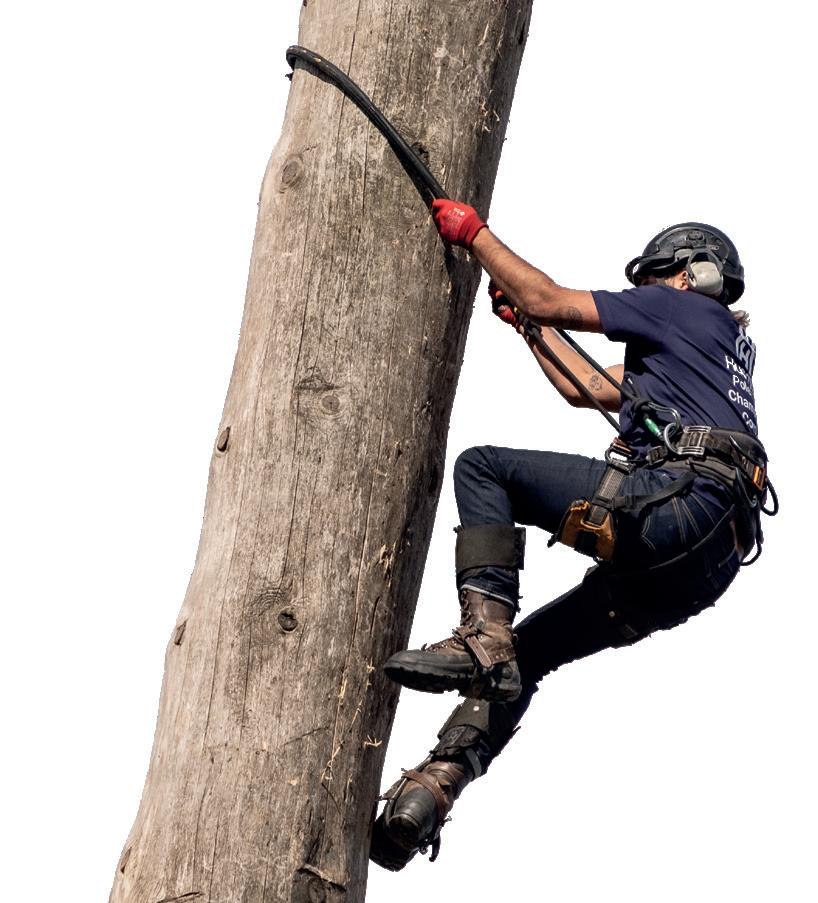
post and wire championships.
The Teufelberger and Pfanner APF tree climbing competition is a new event and will utilise a very large, old Oak tree which you might recall was in the centre of our catering area at previous events. The tree has now been fully surveyed after various setbacks, including a hornets’ nest, and declared safe. The tree allows 360-degree viewing for spectators. The competition is designed to be fast and exciting to watch and will be a speed contest requiring climbers to ascend the tree, navigate through the canopy and ring a series of bells against the clock.
The UK Lumberjack competition returns testing the skill and strength of the athletes using axes and crosscut saws. There will also be ever popular ‘hot saws’. If after watching the axemen you fancied a go at axe throwing yourself, then you will be able to try your hand at this for the first time since 2002.
Our traditional woodland crafts area continues to be a very big draw for visitors. We will have probably the largest variety of crafts on display anywhere in the UK. Clogs to coracles, wheelwrights to basket makers, rakes to rustic carpentry. If you want to know what a Sussex pimp is this will be the place to find out! We are also hoping to be running a one-day course in rake making.
Horse logging is a valuable method of
timber extraction on sensitive sites and the British Horse Loggers will be running demonstrations and giving advice on all matters horse logging. You will even have a chance to get behind the reins and try it for yourself.
We are keen to get visitors involved and try their hand at a new skill. To this end, the Great Big Tree Climbing company will be enabling you to try tree climbing using a rope and harness. Test your head for heights and see if a career in arboriculture is for you. No excuses for not trying as the minimum age is just six years old!
Our Forest Worker Zone returns with excellent advice on careers in forestry and arboriculture, and a whole host of other subjects such as worker health, training and grants.
All the above is in addition to the core element of the show of 300 exhibitors and £80 million of working equipment. As you can see there is far too much to do in a day. Book into our onsite campsite or into a local hotel and come for two or three days.
Remember Confor members get in for free but you must have your membership card with you. These will be sent from Confor closer to the event.
Full details of the show, maps and a list of exhibitors can be found at www.apfexhibition.co.uk.
Daniel Iddon Director was awarded and Technology the Confor 2024
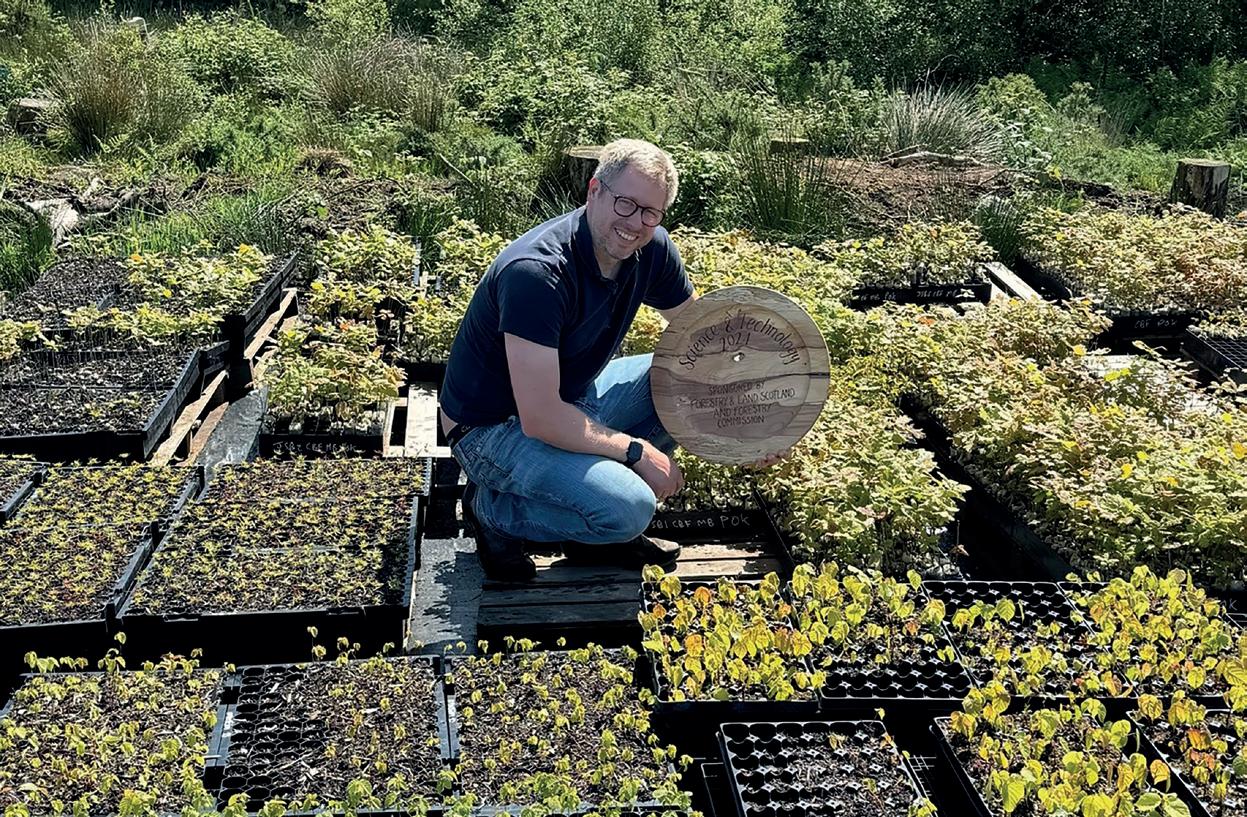
developing a way to bring the complexity of woodland soils into the tree nursery and the use of eDNA in forestry for early stage afforestation.
How do you feel about winning the award?
In some ways I think this award recognises my approach where I have always swum against the tide to do what I think is right when those around often wonder where I am going. It feels like, on reflection, that always asking ‘why’ has its benefits – we get to challenge the norm with new data and approaches without the baggage of experiences that deter risk taking.
That said, we have been working with a lot of experienced foresters and industry experts to get here and so I think I played a very small part in what is a very knowledgeable industry. I am grateful for Confor to shine a light on the work we are doing so more people within the industry can benefit from our research.
Has this always been where your career was headed?
I was 16 years of age when I was told I can always come and grow plants in the family business, but I needed a ‘trade’ to make sure I had experience and a career to provide me skills and a source of income beyond plants. I chose Engineering and for 24 years didn’t look back.
I thought achieving professional registration to be both Chartered and
Fellow within the Institute of Mechanical Engineers by the age of 40 was the trajectory I wanted… until I bought a woodland and started on another journey growing trees.
My skills and experience solving problems and working with nature brings me to today, studying a PhD at Bangor University on fungal communities within early afforestation.
What expertise to you bring into your role?
I have been fortunate to work across a range of industries in my career and I like to think I have brought with me all the good qualities of my peers that I have worked with during that time.
It doesn’t matter whether you are designing a submarine gearbox, reducing weight from a F1 steering assembly or growing Oaks using Fungi. The team you work with and how you can encourage, empower and provide experiences to develop are universal. You always get the best of people when you provide a safe place for people to make educated mistakes and learn from them.
If we all did what our peers and leaders told us to do, we wouldn’t progress as an industry. We are made up of a lot of different ideas, approaches and experiences.
What has been the biggest achievement of your career so far?
I am proud of my engineering career and all that I have achieved and learnt. However, this project has seen us mimic the complexity of woodland soils and breed a microbiome to grow trees
without peat, coir, synthetic chemical fertilisers - and be healthier as a result of using a natural system from forestry materials.
I haven’t achieved anything as profound as that in my engineering unless you think reducing a F1 steering assembly by 2kg is the same?!
What comes next?
The funding for the project is an innovation grant, so a lot of what we have achieved, observed, questioned represents such a small crack into lifting the lid on what nature has to show us. I think we have just started trying to understand how nature behaves and creating the tools to work with nature instead of just monitoring. Developing how we can work with fungi using natural materials and how we can influence soil health, tree resilience and health for the future is the next step.
We are looking forward to continuing our collaborations with A. W. Jenkinson, Euroforest, Pryor and Rickett Silviculture, Land Energy, Leeds University, Bangor University, Myerscough College, Surrey University, NIAB, AgriTech and FERA.
We set up Woodland Grow and Woodland Trees to be the commercial outlets for our research, so whether that is a seed coating, growing medium, inoculated tree sapling or bespoke treatment for heritage trees suffering decline we hope the work we have conducted to date will benefit both society and the industry for years to come.

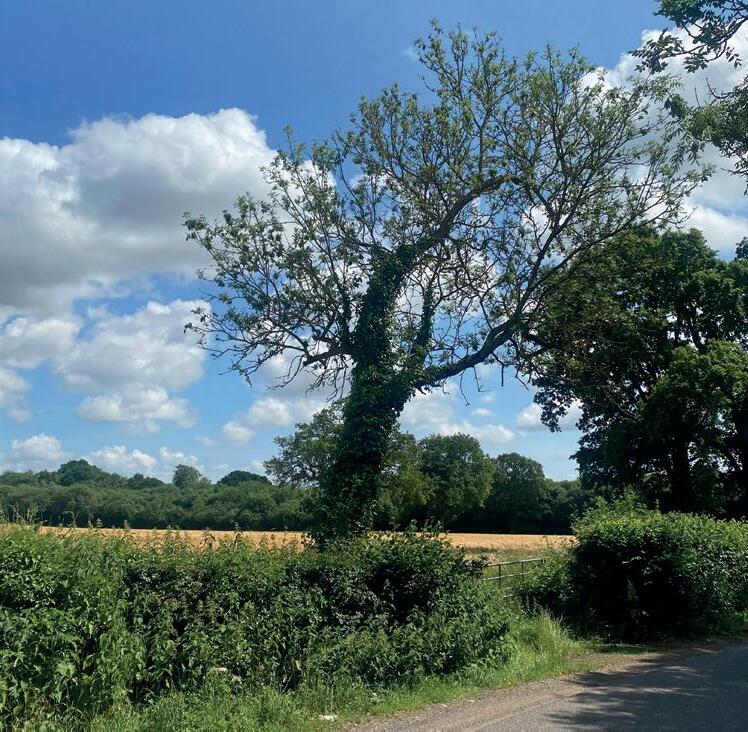
Euroforest are specialists in Arboriculture and offer a range of tree care and woodland management solutions to suit your needs:-
Mechanised Arboriculture
Tree Health Surveys
Tree Surgery
Site Clearance & Mulching
Hedge & Verge Maintenance
Tree Planting & Landscaping
Marketing of Timber and Biomass
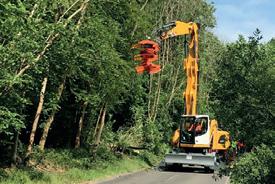
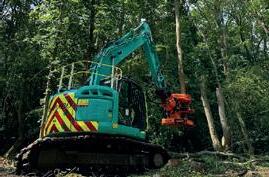

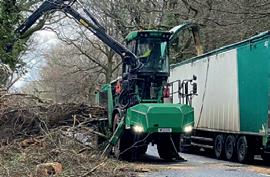





Ash Dieback and other tree diseases con�nue to spread at pace throughout the UK. It is an�cipated that up to 97% of all Ash trees could be lost. Ash and other species at risk are widespread in woodlands and roadside edges. This causes a considerable liability risk to landowners associated with falling trees, especially adjacent to footpaths, highways, and property. Early interven�on is always advised to minimise cost and maximise value.
Euroforest offer a tailored approach to suit all requirements. We use a range of specialist equipment, allowing us to safely dismantle any tree in any loca�on. All of our projects are professionally planned and managed from start to finish, enabling us to achieve and deliver the best results.
Our highly experienced team offer an industry leading Arboriculture service across the country. We lead the way in compliance and public rela�ons, seeing a gold standard through our cer�fica�on to ISO 9001 Quality Management Systems, ISO 45001 Occupa�onal H&S Management and ISO 14001 Environmental Management Systems.
Euroforest's specialist teams offer a bespoke service, from ini�al site appraisal through to comple�on and replan�ng. We offer a service that puts the landowner centre stage while always minimising costs and maximising any �mber revenues. If you wish to find out more, please visit our website or contact us via the below details.

Pupils from schools across the Highlands and Moray to showcase their innovation and learning from their in Young Engineers and Science Clubs (YESC).
Young people and teachers gathered at The Scottish School of Forestry to exhibit their projects and compete for competition prizes. Industry volunteers and partners provided challenges which gave the young people an insight of the different career paths available through studying Science Technology, Engineering and Maths (STEM).
Schools across the country have been taking part in the Climate Smarter project throughout the year, sponsored by Crown Estate Scotland, Confor and The Scottish Forestry Trust. The programme encourages pupils to imagine an ecoschool of the future, engaging them in activities to learn about sustainable materials, energy production, and fitting in with their local environment.
Teacher Ashley West, Fortrose Academy, highlighted: “Taking part in YESC has drastically changed the trajectory of the Science Club at Fortrose Academy. The structured activities encourage pupils to think creatively and outside of the box to come up with ways to tackle real life problems such as the climate emergency through problem solving and scientific investigation
“Throughout the project pupils have been developing their interpersonal skills which has in turn developed a sense of accomplishment and confidence within the students’ abilities. These skills are not only crucial for the STEM industry but are also highly transferable to other areas of study and future employment.”
Thomas Wild, Head of YESC, added: “The projects, in partnership with our industry funders, inspire pupils and help them develop valuable skills and knowledge whilst encouraging uptake in STEM subjects and careers. The celebration event is a culmination of the project and gives an opportunity where young people can showcase their innovation and hard work whilst learning more about different career and education pathways.”
The Climate Smarter project is funded
• Regional Club of the Year Winner: Farr High School
• Regional Club of the Year Runner-up: Balloch Primary
• Climate Smarter Winner: Fortrose Academy
• Climate Smarter Runner-up: Glenelg Primary
• STEM Challenge Winner: Nairn Academy
• STEM Challenge Runner-up: Fortrose Academy
by industry to provide kits to schools. The project sustainable materials, ‘smart’ technologies. to create a tabletop model of their future eco-school, as their entry for the annual celebration competition at The Scottish School of Forestry.
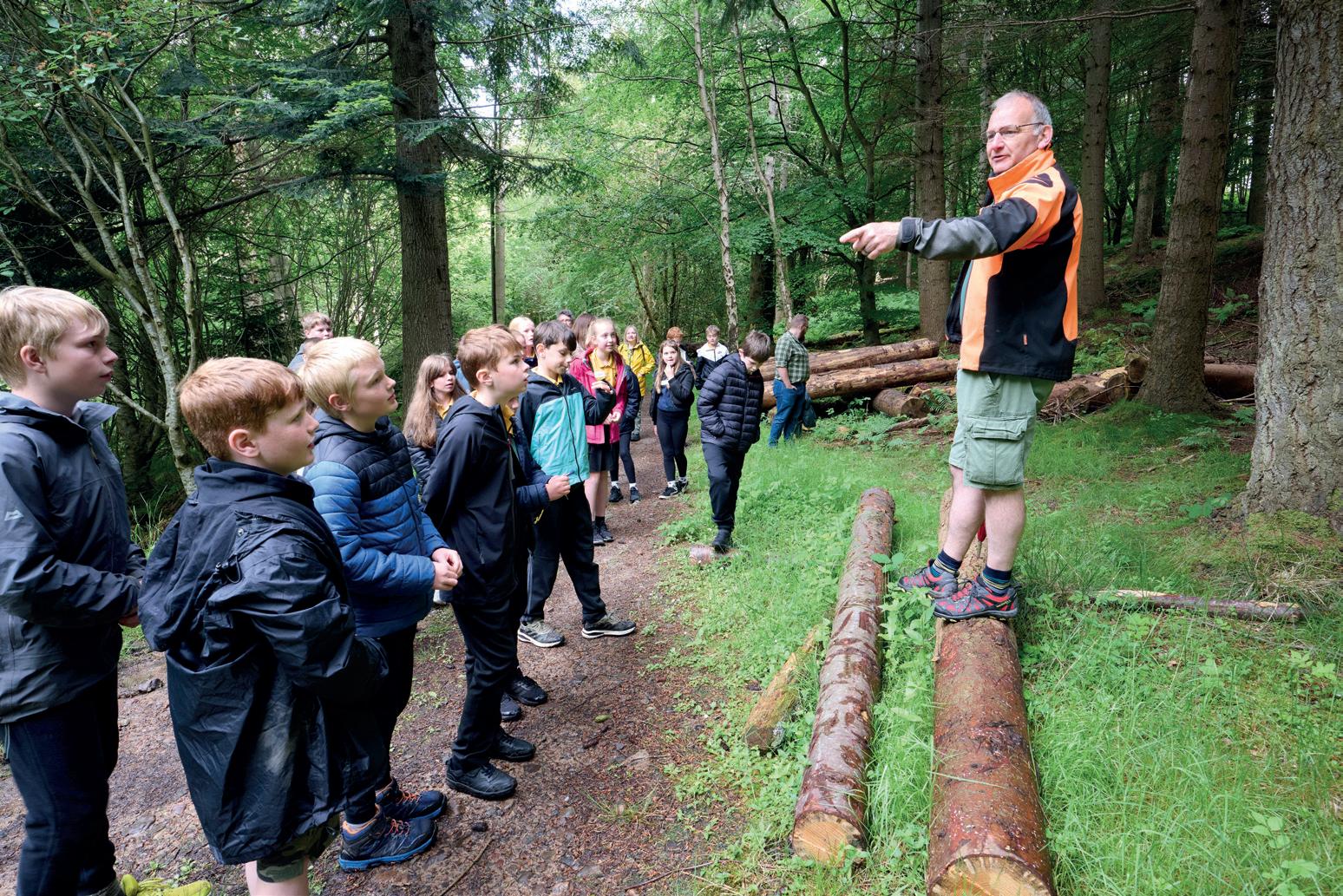
about what skills and interests they may want to carry forward into a career.
The School provided a tour of the campus and careers talks to highlight routes into the industry.
Eleanor O’Neill, Communications Manager at Confor, commented: “The Young Engineers and Science Clubs is a fantastic initiative that we’re always happy to be a part of. It is extremely important to get young people thinking
“The projects put forward by the teams at the Highland Celebration of STEM event demonstrate a real enthusiasm for learning and consideration for the future. I was especially impressed by the strong showing of forestry knowledge this year, proving the impact that these lessons are having on young people’s understanding of the world around them.”
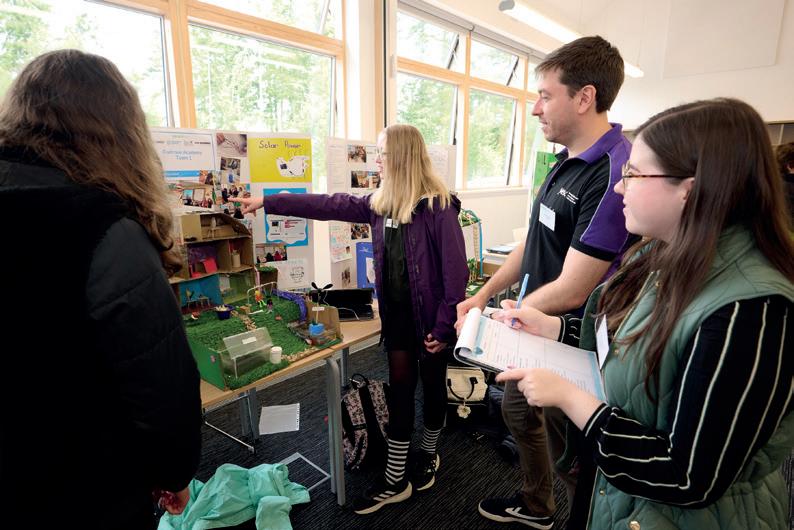



The new Woodland Condition Assessment (WCA) App has been developed jointly by the Field Studies Council, Forestry Commission and Sylva Foundation as part of a project aimed at reducing the complexity and workload for woodland owners and managers. The project was funded by Defra’s Nature for Climate Fund, which is transforming how we grow and manage trees and woodlands in England.
Resource guides and training to help people get to grips with the new technology and build on their biodiversity identification skills have also been developed by the Field Studies Council.
The easy-to-use WCA App improves the speed and accuracy of the existing WCA process which currently requires landowners and managers to fill out and submit complex and extensive survey forms and spreadsheets to obtain results on the ecological condition of a
woodland area.
Neil Riddle of the Forestry Commission, which is leading the project, said the new app allowed reports on woodland condition to be easily generated while providing statistics for the Forestry Commission, and key data about how well woodlands are faring across the country.
“A condition assessment is a key element to help us understand where woodland management can be altered to improve the condition, so it was important that we created a tool that is user-friendly and provides meaningful data to monitor the condition of our woodlands,” he explained.
“Users will also be able to print evidence that they have completed an assessment, all without the spreadsheets used previously which were complex and required a high level of knowledge or experience.
“Our plan is that by developing accessible training and learning
resources, more woodland owners and managers will be encouraged to complete assessments and alter their management practices to benefit biodiversity.”
Users of the WCA App complete a survey while walking through a woodland. This produces scores for a range of features according to their condition. Depending on the cumulative scores across all features, a woodland’s condition will be rated as either good, moderate or poor.
A woodland condition assessment highlights which woodland features:
• have an important influence on wildlife.
• are in good ecological condition.
• will benefit most from improvement.
• are non-native – some of which can be negative for native wildlife.
Sylva Foundation, a charity dedicated to reviving Britain’s woodland culture, provided the design and development expertise for the new app.
Forestry Commission to of eight-toothed spruce
Woodland managers, landowners and the forestry industry encouraged to remain vigilant as the Forestry Commission announced expansion of the current Ips typographus demarcated area in June following of the tree pest on Norway spruce in Anglia.
The eight-toothed spruce bark beetle is a serious pest of spruce trees in Europe and was first identified in the UK in in 2018. It prefers stressed or dying but under the right conditions it can healthy trees and has the potential cause significant damage to Great Britain’s forestry and timber industries.
From Wednesday 12 June, requirements came into force across an extended, larger demarcated area (DMA) in the South East of England and East Anglia to prevent potential spread of the pest, in line with the eradication action taken by the Forestry Commission to manage outbreaks.
The existing Demarcated area, last extended in 2022, covers parts of Hampshire, Berkshire, Buckinghamshire, Hertfordshire, Surrey, City of London, Greater London, West Sussex, East Kent, Essex and Hampshire. After findings of Ips typographus were reported to Forestry Commission, the extended will now cover parts of Bedfordshire, Cambridgeshire, Lincolnshire, Norfolk, and Suffolk.
Forestry Commission spokesperson Andrea Deol said: “Following a report of Ips typographus to the Forestry Commission in East Anglia. We conducted a swift investigation including rapid eradication measures, alongside wider environment surveillance to determine scale of the issue and identify additional suitable management actions.”
Within the demarcated area, the and movement of all spruce material, including trees and wood with bark, isolated bark, and wood chip with bark, is prohibited unless authorised by the Forestry Commission. Woodland managers must provide written notification to Forestry Commission if they intend or kill any trees of the genus Picea A. over three metres in height. Full guidance of the requirements is available on Gov.UK. Additionally, processing of spruce material which has originated in the demarcated area may only be undertaken at premises authorised by the Forestry
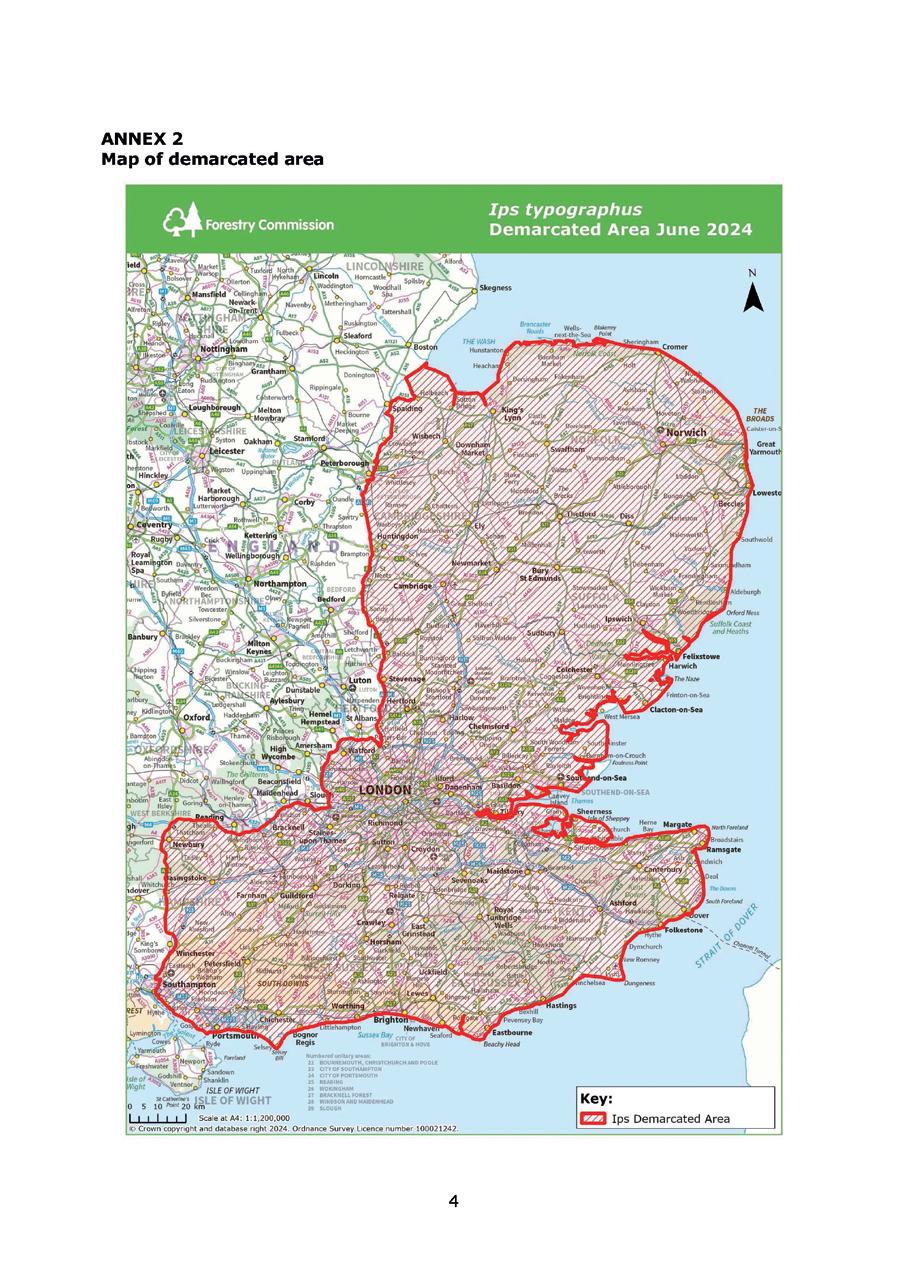
Defra Chief Plant Health Officer Professor Nicola Spence said: “The eighttoothed spruce bark beetle poses no threat to human health but can have a serious impact on spruce trees and the
protocol used for tree pests and diseases. Expanding the demarcated area in response to new findings in 2024 will further strengthen this strategy and continued on p30

The leading project developers for the Woodland Carbon Code, CarbonStore is able to navigate all the technicalities and details associated with securing the necessary accreditation.
100% success rate in validating and accrediting projects under the Peatland and Woodland Carbon Codes, with ongoing checks to certify the project’s standards.
Partner with CarbonStore to help deliver the best service for your clients.
Get in touch with David McCulloch:
t: 07500 950832
e: info@carbonstoreuk.com
w: carbonstoreuk.com





phil@forestcertification.org.uk www.forestcertification.org.uk




Dr Jo Clark has become the first woman to be awarded the RFS Gold Medal for Future Trees Trust project.
Dr Jo Clark, Head of Research at the Future Trees Trust, has become the first person for nearly five years to be awarded the Royal Forestry Society’s (RFS) Gold Medal for distinguished services to forestry. She is also the first woman to receive the award.
She received the medal for a “Herculean” achievement; namely the culmination of the 25-year Future Trees Project to improve UK oak seed for timber production.
The award was made at a presentation by Royal Forestry Society President Ben Herbert at the Future Trees Trust Supporters Day at Buscot and Coleshill Estates in Oxfordshire. Future Trees Trust is the only UK charity dedicated to improving broadleaved trees.
Presenting the award, Ben said: “I am delighted to award the Royal Forestry Society’s Gold Medal, which is rarely and sparingly given, to Dr Jo Clark. Her contribution and knowledge of the future trees we should plant is immeasurable and without her and her work I think we would be at a loss to find what trees we should be planting for the future.”
Future Trees Trust Chair John Leigh Pemberton added: “I am absolutely delighted Jo has been awarded this medal, She has been working largely on her own for 25 years and it takes a very special kind of person to do this.
“Her contribution to the UK’s forestry is huge. There is probably nobody now who is going to have such a beneficial effect on UK forestry.”
Citation
The citation for her award reads: “Jo has been tireless in her work to improve our timber species. Starting with liaison with landowners and foresters to find the very best “plus trees”, working with nurserymen, finding sites for progeny trials and working with their owners.
“That is just the beginning. From there grafted material is planted out in carefully laid out and recorded trial plots. Years of data is collected and analysed before sites can be rogued to produce seed orchards of the finest genetics from which the ultimate “Tested” quality seed is eventually produced.
“This is a Herculean task and one that

goes on to a large extent “under the radar”, for it is future generations that will really benefit from Jo’s painstaking work. It is her work that will ensure that our woodlands will be capable of producing better timber.”
Jo began her career working for the US Forest Service on the selection of native species, tree breeding and management of seed orchards and progeny trials in the Pacific Northwest of the USA.
She holds a BSc in Plant Biology, an MSc in Natural Resource Management, and a PhD from Bangor University for
her work on the adaptation of Ash to climate change.
After eight years working in the USA, Jo joined the Northmoor Trust (later to become the Earth Trust) as manager of their 40-acre research woodland at Paradise Wood. In 2013 she was recruited by the Future Trees Trust as Research Coordinator. She became Head of Research in 2018.
She joins an exclusive group of Gold Medal holders. Hers was the first Gold Medal to be presented since 2019 when Geraint Richards, Head Forester for the Duchy of Cornwall, received the award from the then Prince of Wales.
continued from p28
prevent this pest becoming established.
“As we enter the flight season, increased vigilance is needed, and any sightings should be reported to the Forestry Commission via its TreeAlert online portal.”
The Forestry Commission continues to robustly manage this pest and prevent its establishment within Great Britain. Landowners, managers and timber processors should remain vigilant for Ips typographus and are encouraged to continue to check the health of spruce trees on their land especially as temperatures rise and we enter the flight season.
Any suspected findings of the beetle can be reported using the online portal TreeAlert.
For authorisation to commence felling, move or process spruce material that has originated in the demarcated area please contact ipstypographus.authorisation@ forestrycommission.gov.uk.
Landowners and managers served with a Statutory Plant Health Notice due to an outbreak on their site may be eligible for grants to support felling and restocking activity through the Tree Health Pilot. The Forestry Commission is encouraging landowners to proactively remove spruce from the South East of England and replant with other non-susceptible species.







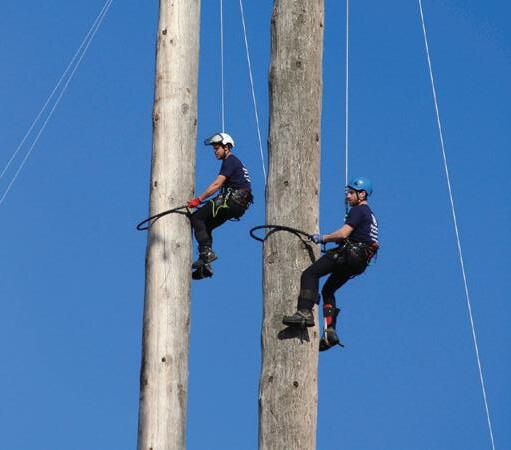


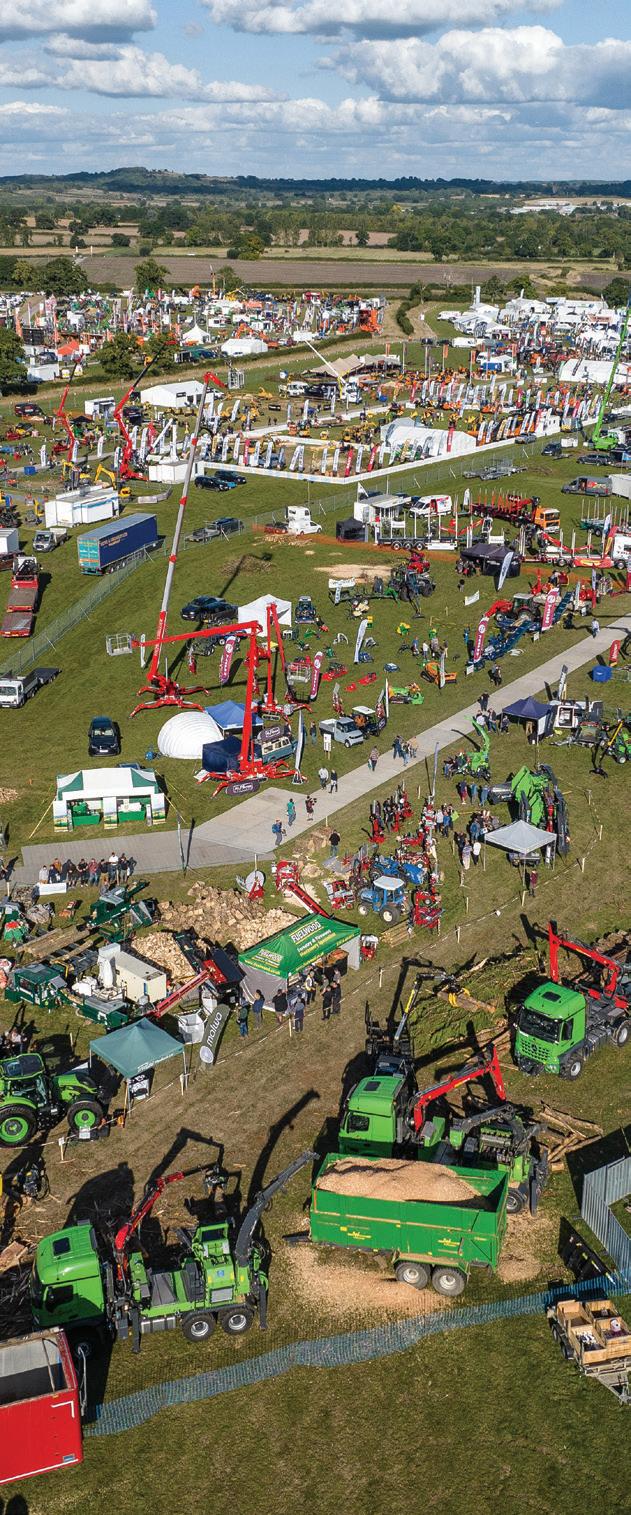




As part of a national drive to promote the benefits of tree planting to farmers, a limited number of free Farm Woodland Assessments are being provided by Scottish Forestry.
Farmers and land managers in the central belt, who are thinking of planting trees but don’t know where to begin, are now being offered free woodland assessments from Scottish Forestry.
The offer applies to farmers in the central belt from Ayrshire, Inverclyde, and Dunbartonshire right across the west to Fife and the Lothians in the east.
Since 2016, 78 assessments have taken place in the central belt, resulting in over 600 hectares of new woodland being planted. Last year alone, nine assessments were completed, covering over 1,000 hectares of land. From these assessments, 319 hectares of potential new woodland creation was identified.
The assessment gives farmers and landowners a free report detailing potential areas for planting and any constraints, available forestry grants, and valuable information on projected income and expenditure. Focussed on the objectives of the landowner, the assessment seeks to find ways to integrate trees into the farm to strengthen and diversify their business.
Will Chadwick, Woodland Creation Officer with Scottish Forestry, said: “Trees
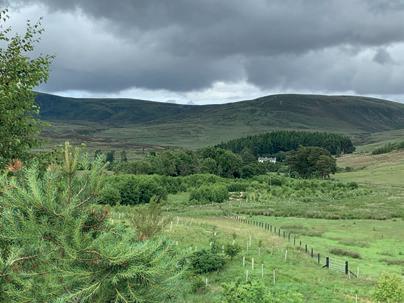
opportunities and equip them with the necessary details to make an informed decision on whether to go ahead with tree planting. The Farm Woodland Assessment is a great way to do this, with tree planting potential mapped out for them, all for free and with no obligation.”
Encouraging tree planting on Scottish farms is a key driver of the Integrating Trees Network, which recently held an event showcasing best practice at the Rottal Estate in Angus. Key Scottish Forestry staff attended to provide advice on forestry grants and how best to apply.
Lyn White, Forestry and Farming Development Officer, said: “The Integrating
“There are many forestry grants that farmers can take advantage of, and we will be able to discuss these in full on the day.”
Dee Ward owns and runs the 8,000acre Rottal Estate and has transformed the estate’s natural capital through a number of environmental improvements, which include increasing tree cover in key locations.
He explained: “We’ve taken action over the years to really boost the environmental benefits of the estate and with this it has also brought multiple business benefits too.
“I’d like to share how we went about transforming our estate, covering what our vision was, our objectives and what actions we implemented.
“The benefits from increasing woodland areas on the estate are very tangible. They range from boosts to biodiversity, shelter and shade for livestock, helping to increase fish numbers, and mitigating flood areas as well as carbon sequestration.”
Applicants for a free Farm Woodland Assessment must be within the Central Scotland Green Network area, with an added focus around the Clyde Climate Forest and Forth Climate Forest catchments.
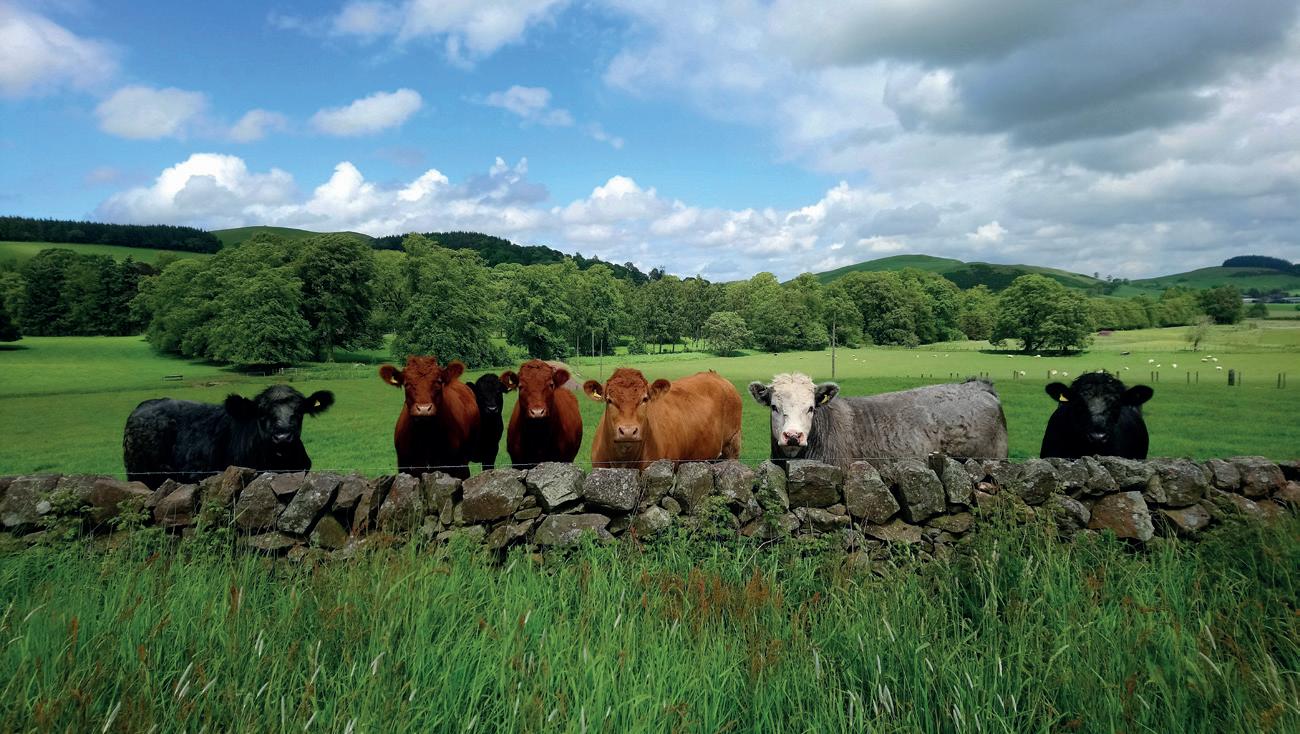
There are a limited number of assessments available, so farmers and landowners are advised to register interest quickly, with deadlines for applications to be in by 20 December 2024. Applications will be assessed on a monthly basis with the first assessments being carried out from July 2024.















Future Trees Trust, the only UK charity dedicated to improving broadleaved trees, has announced the availability of superior quality oak seed, in the Tested category of Forest Reproductive Material (FRM), for the next generation of oak.
Oak is the largest, longest-lived and most important broadleaf British timber tree. However, the period between seed sowing to final harvest is a long one, which can result in high UK imports of oak.
Future Trees Trust has been working for 25 years to improve the quality of homegrown oak timber and to create seed orchards which will produce acorns that fall into this highest category of FRM.
The research first began during the 1990s, when Future Trees Trust selected pedunculate oak (Quercus robur) and sessile oak (Quercus petraea) ‘plus trees’ based on their timber characteristics. Eight progeny trials were established in 2003 to assess growth rates and timber traits.
After 18 years of assessments two trial sites, Sotterley Estate in Suffolk, and Little Wittenham in Oxfordshire have been rogued to a single species, forming the first Tested seed orchards for oak in the UK; one for Quercus robur and one for Q. petraea.
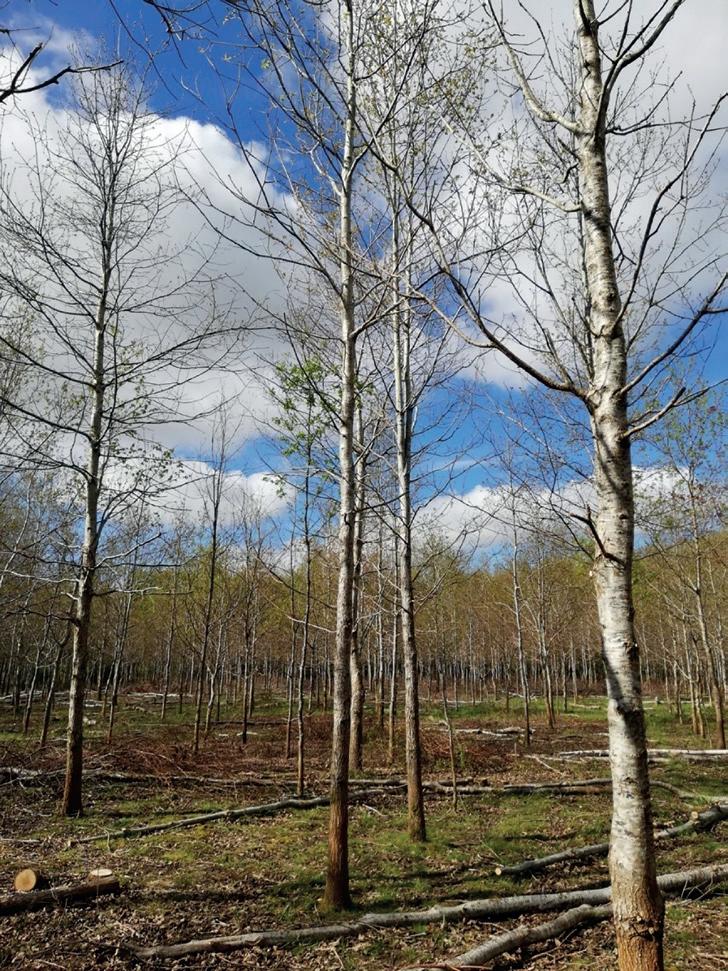
The orchards have now been placed on the FRM register and will significantly contribute to the maintenance and restoration of resilient, healthy oak across the UK. The quantities of tested acorns available to industry will increase as the trees grow and mature. The availability of this first of a kind Tested oak seed will allow superior growth and shorter rotations for UK growers, coupled with other quality timber traits such as lighter branching and straighter stems.
Jo Clark, Head of Research at Future Trees Trust said: “It’s really exciting to see the first tested FRM for a broadleaved species, following many years of hard work and research. The amount of
tested seed coming from these orchards will be small over the next few years as crowns develop after the rogueing but this will increase as the trees grow and develop.
“A huge thank you to all the landowners who have hosted the trials, and everyone involved in creating the orchards to finally bring tested oak seed to the forestry industry.
“Oak represents the bulk of UK hardwood imports mainly sourced from Europe and the US. This step forward in research will allow UK forestry to secure a future for oak hardwoods in the UK, by sustainably producing homegrown oak timber, reducing reliance on imports.”
Gresham House, the alternative asset manager, has raised £50m from South Yorkshire Pensions Authority for Gresham House Forest Fund VI LP, an asset-backed forestry fund that aims to deliver robust, diversified returns for investors while contributing to lowering emissions and supporting biodiversity.
Gresham House Forest Fund VI LP was launched in March 2022 and provides investors with a diversified portfolio of forestry assets around the UK. Targeting a net IRR of 8%, it generates returns through the harvesting and sale of sustainable timber – which is increasingly being used as a lower-carbon alternative to traditional building materials – alongside the capital growth of the underlying land.
Over and above the target core financial forestry returns, the fund is expected to sequester 4.7 million tCO2e over the next 25 years, and investors in the fund also have the opportunity to receive distributions in the form of carbon credits, which can be sold to provide an additional return or retained for carbon insetting purposes.
The estimated accumulated certified carbon credits, based on a £400mn fund size, could be up to a million credits over 25 years, subject to the level of new planting land acquired into the portfolio.
The commitment from South Yorkshire Pensions Authority builds on existing backing for the strategy from Worcestershire Pension Fund and highnet-worth individuals and brings the fund
to over £150m in size.
Further closes are also planned for the strategy, with institutional investors increasingly recognising the ability of forestry investments to provide compelling financial returns while delivering a positive impact in terms of emissions, biodiversity and job creation in rural communities.
Gresham House is the UK’s largest forestry manager and a top 10 natural capital manager globally, with £3.5b in forestry assets under management.
The commitment from South Yorkshire Pensions Authority follows a busy period of inflows across Gresham House’s real assets strategies, with its ReSI LP shared ownership housing fund recently securing £125mn from Gloucestershire Pension Fund and Devon Pension Fund.


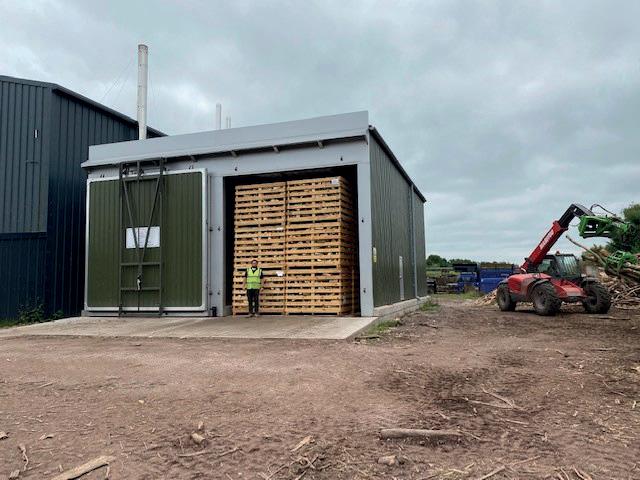

Offering a comprehensive range of professional log & woodchip drying kilns for the timber industry. Along with kilns for sawn timber, pallets & fencing producers
KILN Services has been designing and manufacturing timber-drying kilns from its base in Essex for over 45 years. The company provides drying and heat-treatment kilns for all sectors of the industry, including softwood and hardwood sawmills, pallet manufacturing, fence-post producers, biomass fuel producers, modified timber and research facilities in universities and training colleges. In recent years, the market for kilns to dry biomass fuel has increased considerably. This has been driven by consumer awareness of product moisture and government initiatives to improve air quality, such as the Woodsure Ready to Burn accreditation scheme.
Please visit our website for more information www.kilnservices.co.uk t: 01621 785 935 e: kilnservices@btconnect.com Kiln Services Ltd, Essex, CMO 8TE

The SAF Woodland Management Living Soil project under the Tree Production Innovation Fund is now in its third year and while the project team have achieved the seemingly impossible, in a lot of ways they have only just started in the journey of growing trees in the most natural and sustainable way. Daniel Iddon provides an update.
Innovating across seed coatings, growing medium, Forestry Ellepots, inoculated trees saplings, natural fertiliser and impregnated tree guards, the team isn’t planning to stop at the end of the project. The next phase will strive for a future where we remove glyphosate from use within the forestry industry with a fungal based
alternative to favour the trees.
The project’s aim to mimic the complex and rich fungal soils of a woodland using a zero waste and circular economy approach, and to bring life into the tree nursery as an alternative to peat and synthetic fertiliser was ambitious, to say the least.
More than 90% of fungi have yet to
be found and formally described by scientists, according to a new report from the Royal Botanic Gardens, Kew. The report estimates that there are 2.5m fungi species around the world. Every year, scientists around the world name about 2,500 new species of plant and the same number of fungi.
In 2023, RGB Kew researchers named 74 plants and 15 fungi species. It will take approximately 1,000 years to identify all fungal species at that trajectory. Additional work will be required to identify the fungal type, function and relationships between different fungi and bacteria groups and microbes.
We believe nature knows more than scientists do – one fungal species does not do the job of everything, so we don’t extract fungi – we work with it and breed a smorgasbord that are healthy and beneficial. Like baking a cake, you can’t bake with missing ingredients or the incorrect ratios. This is the same when breeding a fungal microbiome to grow trees.
Fungal inoculations over the years have been of interest to the forestry industry but also illusive to the net output for this very reason. If we acknowledge that we know too little of nature’s toolbox to understand, then we need to look at the problem differently. Let’s trust nature and use data to make informed decisions –mother nature knows more than we do, so let’s work with her.

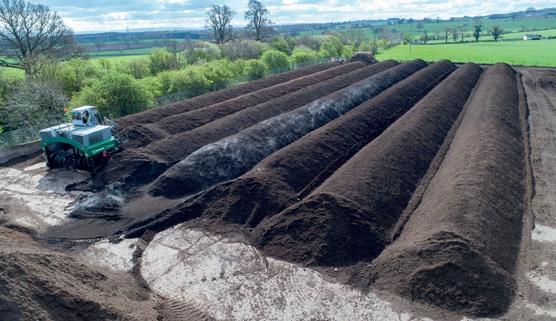
Working on the intersection of physics, chemistry and biology has been an absolute privilege. In our journey, we have developed techniques to breed a complex microbiome that is richer and more complex than peat-free growing medium imported from the Netherlands. The growing trials have shown how peat-free forestry residue with nutrients doesn’t grow trees, but when fungal communities are introduced, the trees grow comparable, if not healthier than those grown in synthetic fertiliser and peat free.
“In addition to bringing a sustainable alternative to peat to market, this innovative project aims to develop a growing media tailored to tree production that will improve germination and establishment rates,” said Jack Clough, Grant Manager at Nature for Climate Fund.
The project has been supported by the Tree Production Innovation Fund and is now in its final year. The team have created a more diverse, rich and diverse microbiome full of beneficial fungi, including mycorrhizal fungi, than currently available on the commercial market with a technique that is scalable to provide for the entire tree production needs of the UK every year, including fertiliser to inoculate planting sites.
A reflection on our experiences and lessons learnt during our growing trials, where we grew 100,000 trees across

England, Wales and Scotland, has demonstrated there is a natural nonextractive approach to grow healthier and more resilient trees without peat or synthetic chemical fertiliser using the power of a diverse and rich fungal microbiome.
A series of planting trials over the last Winter took place from Devon, through to Wales, Oxford and Cumbria, and Scotland will see Oaks and Hazels measured in trial plots to provide the data the industry has come to expect from Forest Research. The trials have been conducted with Pryor and Rickett, Flintshire Woodlands, Woodland Trust, National Trust and a range of industry stakeholders.
During seed trials with Forestart and Alba Trees, the team saw an increased growth rate within the nursery of 10% in both collar and height compared to commercial peat-free growing medium.
The soils in our woodlands are the most complex, undisturbed and as a result of the Living Soil project, able to now utilise forest residues to replace peat and synthetic chemical fertilisers in the UK and further afield in Forestry, Horticulture and Agriculture.
Daniel Iddon, project lead at SAF Woodland Management predicts our forestry soils and ecosystem will be the saviour of our food and timber security within the 21st century as we move
towards net zero and zero waste due to one organism: fungi.
The forestry industry moves slowly, yet on the Living Soil project funded by the Tree Production Innovation Fund we have been making achievements that a year ago felt like an optimistic dream. We are often told this project is too good to be true with its ability to grow trees using fungi in a nursery and yet we continue to show how we don’t need peat or synthetic fertiliser.
Daniel has begun another journey by studying a PhD at Bangor University on fungal communities within early afforestation soils given the work we have conducted to date and encouraging results on the resistance of the trees to airborne pathogens and diseases typical of tree nurseries.
Forestry can be the saviour of agriculture, horticulture and agroforestry given that the soils and environment remain intact compared to agriculture that either plough, till or apply glyphosate leaving soils devoid of fungal communities where root feeding nematodes are taking over impacting establishment rates.
There is a profound sense of responsibility working on a project as exciting as this one. Given the long-term research in forestry has typically been undertaken by the state or research institutes, I for one am grateful for the Forestry Commission support over the last continued on p38
continued from p37
three years via their recent grant Tree Production Innovation Fund Production Capital Grant.
Having benefitted from public investment, we want the work the public and those in the industry sharing our successes and lessons
Before we started this project industry used peat or peat-free medium but exclusively across with the addition of synthetic provide the N required to produce We can now grow trees using sourced in the UK with native without chemical synthetic fertiliser, coir, perlite or contaminated green compost – who will continue to materials now there is a natural Woodland Grow and Woodland Trees have now invested £1M over the last five years with additional support from the Welsh and Scottish Governments to create the new standard in growing trees. Working with a range of stakeholders across the industry is how we can bring the much needed scale and shift from the chemical basis in which we operate today.
The work continues

Analysis of growing medium microbes identified that Jiffy (imported from the Netherlands) contained no core microbiome fungi compared to bark fines collected from the largest repository of fines in the UK.
The Oaks grown were free from Mildew even when located next to peat-free growing medium that suffered from July to September.
The output from the innovation can be seen across the use of fungi within the journey from seed to woodland.
Woodland Seeds are now able to provide seeds coated with microbes and early-stage nutrients to support germination and growth. Woodland Grow is the first and only supplier of a growing medium for trees with cutting edge knowledge on what a tree needs to grow healthily and naturally without synthetic chemical fertilisers. Woodland Trees is the first and only tree nursery in the UK and quite possibly the world growing trees with just fungi and natural sources of nutrition on a commercial scale.
Our growing trials across England, Wales and Scotland saw us grow in a variety of formats and scenarios with only benefits of the growing system compared
Analyses of soil microbes are so simple and yet the industry is unaware of the benefits, often blaming climate change or any other go to reason to justify additional maintenance costs to landowners. We need to change this narrative and like in agriculture test and develop our soils over time to benefit the crop not just what helps keep initial costs down, only to create more work and costs later.
Ground preparation is an annual debate, with a range of considerations to account for in determining the most efficient approach. Analysis has shown mounding on new planting sites creates a bacteria party at the detriment of fungi which doesn’t then get remediated. Trees need fungi and a lot less bacteria. Feeding complex foods benefits trees and fungi which is different to trying to kill grass with glyphosate that kills the beneficial fungi - I think it is far better to help the
dominated

We are growing 60,000 trees at Woodland Trees and 50,000 at FC Delamere Nursery. We will start the production of 500,000 grown at Alba Trees over the summer for season P25/26. The output of the project will be a legacy of how innovation can benefit both the industry, soils and trees.
Maximising the sequestration of carbon in soils and tree growth will only be achievable if we use natural and sustainable sources of nutrition and microbes.
Bringing forestry and agriculture closer together
Recent innovations in agriculture using the same techniques developed in forestry has seen the project team grow salad crops and Winter Barley without the use of synthetic fertilisers or peat.
The opportunity for forestry to displace the 1M Tonnes of Chemical Synthetic Fertiliser and 3.3MTCO2e used in Agriculture every year with forestry residues while adding value to a coproduct stream is significant.
Who is ready to join the shift away from using synthetic fertiliser in land management and rely solely on natural, circular economy-based materials?



The Exeter Retort is available to order. Produces high quality barbeque charcoal/biochar in a fraction of the time taken by traditional ring kilns. 07515 683908 www.carboncompost.co.uk admin@carboncompost.co.uk
Servicing and Repairs of all
Machinery Specialising in excavator conversions for the forestry industry



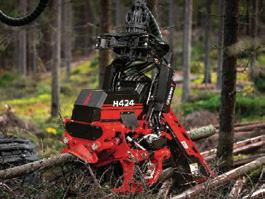
info@rcfengineering.co.uk www.rcfengineering.co.uk



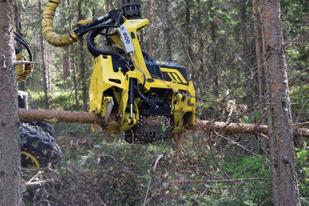

RTS Forestry are pleased to be recruiting for 3 new positions of forest manager with one role each based in Inverness, Crieff and South Scotland. These are ideally suited to forest managers ready to take the next significant step in your career in terms of forest management responsibility.
In Inverness our team at RTS Forestry have seen consistent expansion of the local client base since the office was opened in 2021. We are looking for a forest manager with at least 3-4 years’ experience to join our existing team and who shares our commitment to delivering high quality service to client’s objectives and making a positive impact through your work.
In Crieff, which also serves as the Company head office, you will join a team of 12 likeminded professional foresters in managing a wide range of local forests with a diverse ownership including private individuals, investment funds and conservation organisation. You will already have a number of years of forest management experience and an interest to take professional ownership in the management of the forests within your portfolio.
In South Scotland we have committed to developing a new office to service existing managed properties in that area. We are willing to discuss with the right candidate the location of this o ffice and to also facilitate a degree of hybrid working. This new office will initially have two forest managers and in addition you will also work closely with the existing forest managers in our Hexham office. With large scale expansion in our forest management portfolio in the area it is an exciting time to deliver the RTS Forestry management services in South Scotland
For each of these three positions you will be interested to develop significant autonomy after a period of introduction to the properties we are privileged to manage. With our highly experienced senior managers for support you will both manage the existing portfolio and have the opportunity to become involved in business development...
In your role, you will have the opportunity to work on challenging and rewarding projects, including traditional management of commercial and native woodlands, the creation of new woodlands, renewable energy initiatives, and consultancy services. You will also be responsible for ensuring compliance with all relevant regulations and fostering strong relationships with clients and stakeholders.
At RTS Forestry, we believe in recognizing and rewarding the individual talents of each team member and we strive to adapt your professional direction to your specific skills and preferences.
We encourage continued training in any specific areas of interest. We will assist in gaining of professional membership of the Institute of Chartered Foresters or another relevant professional body.
RTS Forestry offer an attractive salary which fully reflects experience and a wide-ranging benefits package including: Private health care Pension contribution and option of salary sacrifice up to 31 days of holidays
Company annual bonus scheme
Company car
Lesley.Mackenzie@rtsforestry.co.uk • 01764652858 www.rtsforestry.co.uk
Company annual
Welsh Government came together with Forest Research, Woodknowledge Wales, Confor and Bangor University to host their first knowledge transfer day on 13 June. This has given the industry a strong message of their engagement in the sector.
Around 100 hybrid attendees were welcomed to the first Forestry Knowledge Transfer Day in Wales by an address from Nicolas Turner, Head of Forestry Reform, Welsh Government. Presentations from Forest Research included an introduction from Tom Jenkins, Head of Forest Research in Wales, and then Dr Gail Atkinson, Head of Climate Change Science, discussed adapting forest and woodland management to the changing climate. She introduced a new practice guide on the subject, as well as Forest Research’s Climate Change Hub.

Chris Reynolds, Silviculture Project Leader, then went into the work being done around alternative timber species for Wales, including the emerging species programme and species diversification to maintain and increase productivity. Robert Matthews, Head of the FR Forest Mensuration, Modelling and Forecasting Science Group, took attendees through the challenges surrounding quantifying the sustainable forestry carbon cycle. He emphasised the potential for carbon sequestration and avoiding GHG emissions through the use of harvested wood products in place of other materials.
Finally, Dr Roger Moore, Senior Entomologist, brought the discussion around to the problem and management of Hylobius, touching on plant protection through use of insecticides, fallow, and biocontrol.
After lunch and networking, Natural Resources Wales’s Timber Sales and Marketing Manager, StJohn Ashworth, provided an update on recent pilots of alternative timber sales methods and then Andrew Wright, Senior Specialist Advisor – Plant Health and Knowledge Transfer, discussed harvesting and the challenges of the changing climate.
Gary Newman, Chief Executive of Woodknowledge Wales presented a


round up of their ongoing work, including the Home-Grown Homes 2 project. Confor’s Elaine Harrison then hosted an Industry Panel with Confor members Ben Goh, Commercial Manager, Maelor Forest Nurseries Ltd, and Iwan Parry, Tilhill Forestry.
Elaine posed the question to the delegates: what topics would you like to see at future Knowledge Exchange events?
There were some great discussions on what the delegates wanted support
with from Welsh Government, up to and including revising public procurement with using UK timber, assessing priority habitats, grey squirrel management, skills, access to land to plant trees, and relationships with farm advisors.
Welsh Government have confirmed they have allocated budget for facilities more of these events. There are plans for days like this to run as a series going forward and Confor will be developing this further for the forestry sector in Wales.
TreeStory unveils TreeStory Learn, a comprehensive, accessible, and hands-on regenerative forestry programme led by Dr Jens Haufe.
TreeStory Ltd has announced its latest venture ‘TreeStory Learn’ with the appointment of Dr Jens Haufe as Senior Silvicultural Consultant. Dr Haufe has over 30 years’ professional experience in forestry, researching and teaching on silvicultural practice across the UK, most recently working as Technical Development Manager for Forest Research.

TreeStory Learn will offer courses in Regenerative Forestry practice, moving beyond sustainable forestry to leave ecosystems in better condition than they were before, building on TreeStory’s core
good forestry can have impact on people the planet.
“In launching TreeStory Learn, we aim to make the teaching of Dr Haufe available to all foresters. As one of the country’s leading forestry experts, Jens brings with him a deep knowledge of forest development types, the effect of climate change on species selection, and an unparalleled understanding of innovative silvicultural systems that work in Scotland,” said Gordon Brown, CEO and Co-Founder of TreeStory.
“We are so excited to have Jens join us, bringing with him over 30 years of professional experience, which positions him to lend invaluable insights into
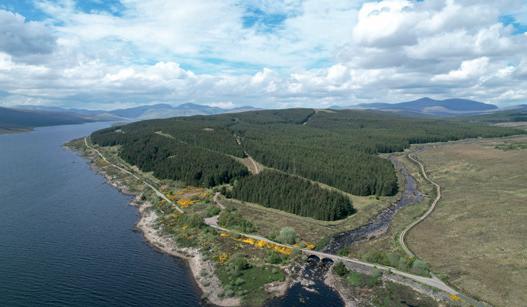
LOCH SHIN, SUTHERLAND, SCOTLAND
Area: 91.40 Hectares / 225.85 Acres
Outstanding lochside forest with maturing timber, good access, deer stalking and fishing rights.
woodland creation, management and innovation away from ‘business as usual forestry’.”
The Regenerative Forestry Programme builds from basic forest science and silviculture, through to advanced management decision making and operational planning and is focused on providing participants with the knowledge and confidence to practice regenerative-style forestry.
The programme will be delivered in modules, following the grow cycles of a forest, including: ‘Site assessment and tree species selection’, ‘Forest establishment’ and ‘CCF’. Participants can pick and choose the modules most appropriate for them. Each module will typically last three days, and all are taught in person by Jens Haufe and include site visits and exercises.
For more information and to book, please visit: treestory.org.uk/learn or contact learn@treestory.org.uk.
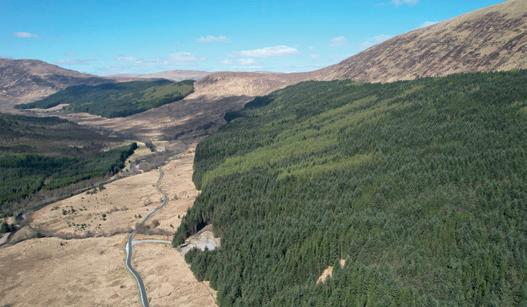
GLEN
NEAR FORT WILLIAM, LOCHABER, SCOTLAND Area: 228.46 Hectares / 564.52 Acres
Significant volume of mature timber with approval to fell and replant with a high proportion of Sitka spruce. FOR SALE - Offers Over £900,000 FOR SALE - Offers Over £3,000,000

Toseedetailsoftheseproperties andotherscurrentlyforsale, pleasevisit:www.landfor.co.uk
Selling Agent: Patrick Porteous +44 (0)7444 559510 patrick@landfor.co.uk • www.landfor.co.uk
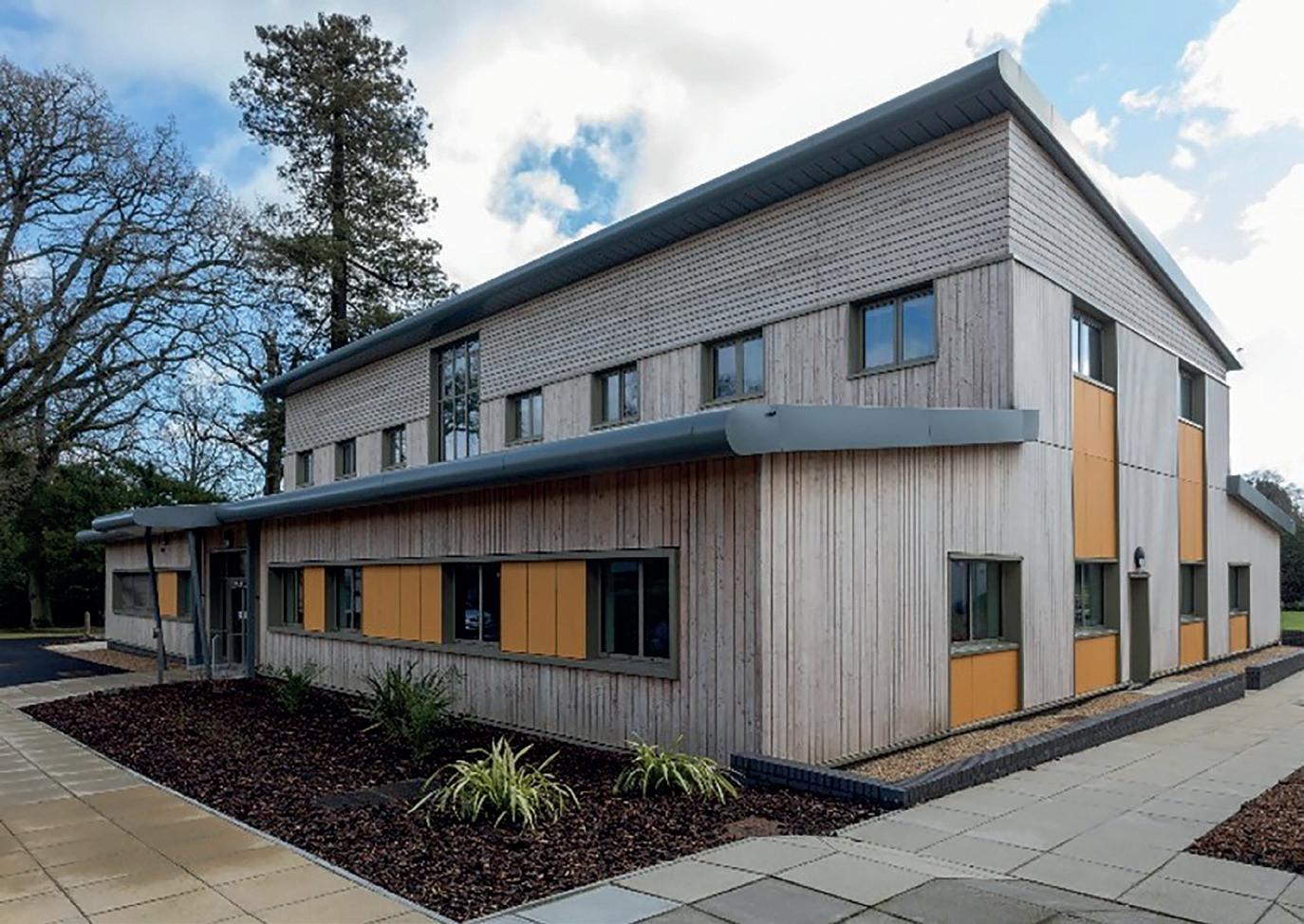
£4 million allocated to expand world-leading laboratories working on increasing UK biosecurity and tackling emerging threats to tree health.
The battle against tree-disease spreading beetles such as the Emerald ash borer and the larger eight-toothed spruce bark beetle has taken a significant step forward thanks to new government funding. The sum will pay for a new £4 million research and containment facility at the UK’s Forest Research Alice Holt Research Station in Surrey and will better equip the country in managing the risks posed by these harmful pests and pathogens.
The new facility will expand the capacity of the existing Holt containment laboratory by almost double. This will boost capability to study pests and pathogens in a contained and
controlled environment – enhancing our national response and facilitating safe international trade.
Defra Chief Plant Health Officer Professor Nicola Spence stated: “Pests and diseases are a threat to our nation’s trees and plants. They cause significant damage, economic losses and in many cases tree death. Tackling them is a key part of commitments set out in our world-leading Plant Biosecurity Strategy to protect our nation’s plants and trees.
“Funding this new facility at Alice Holt will boost our capacity in the fight against new and emerging threats and help us maintain some of the strongest biosecurity measures in the world.”
Statistics released by Forest Research show there were 2,350 tree pests and diseases reported via the TreeAlert service from April 2023 - March 2024.
By assessing the pests and pathogens in a contained laboratory, scientists from Forest Research – Great Britain’s leading organisation for forestry research – will be able to study them in a safe and controlled manner using cutting-edge technology and equipment to safeguard our treescapes.
“The Alice Holt Research Station has played a key role in researching pests and pathogens to protect our forests, strengthening UK-wide efforts to combat pest and disease outbreaks,” said Forest Research Chief Executive Professor James Pendlebury. “It is important that we increase our capacity to combat these threats so we can continue our worldleading research. This investment will help Forest Research fight to safeguard our trees and woodlands for future generations.”
Due to a changing climate, we are seeing a rise in the number of pests and recent years have seen an increase in the eight-toothed spruce bark beetle Ips typographus and ongoing responses to Phytophthora ramorum and oak processionary moth.
The laboratory will also help prepare for known threats which are not currently present, such as Emerald ash borer – an exotic emerald coloured beetle from Asia which has spread to North America and caused significant damage to ash trees – and Xylella, a ferocious bacterial disease which has devastated olive trees in France and Italy.
This announcement supports delivery of the Plant Biosecurity Strategy for Great Britain, which committed to work with the industry and general public to protect the country’s plants from risks posed by pests and pathogens.
The government has ambitious targets to increase tree canopy and woodland cover in England to at least 16.5% by 2050 and continues to take action to meet this with more than 15 million trees having been planted this Parliament, with future proofing our forests from disease a key part of our plans to increase tree cover.
Biosecurity Minister Lord DouglasMiller commented: “We are committed to protecting the country’s tree health and maintaining biosecurity to ensure our trees and woodlands are resilient to fight climate change. Building on the existing vital work of Alice Holt will be a key part to achieving this.”
In a further move to protect the UK from harmful pests and diseases, the government has introduced a new set of global, risk-based border controls which will improve UK biosecurity, part of the Border Target Operating Model.



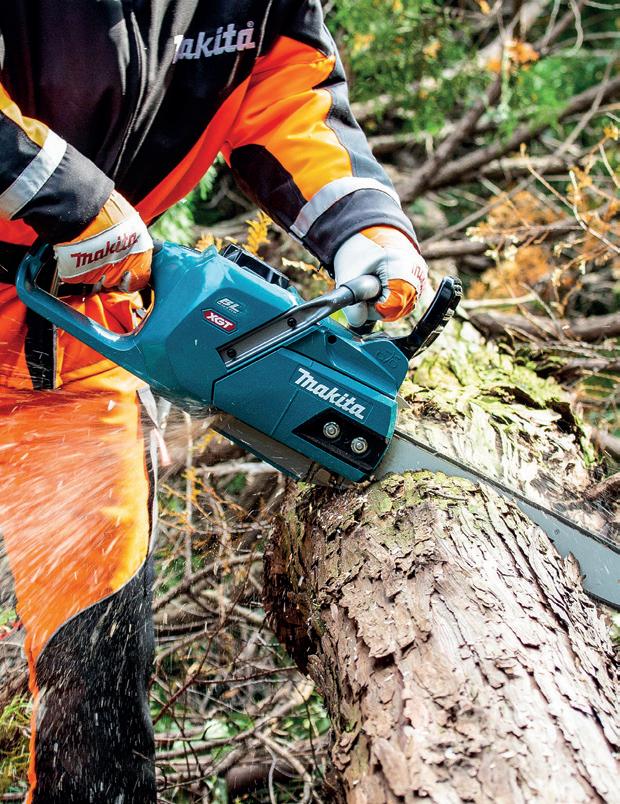


While the price of heating oil and mains gas increase three-fold, little thought is given to sustainable heat alternatives for off-grid homes and businesses in rural areas of the UK. Land Energy explain the perks of wood pellet biomass and how a short supply chain is economically and environmentally sound.
Homes which are often old and draughty with poor insulation are unsuitable for ground and air source heat pumps which rely on ambient, consistent temperatures. Scotland-based Land Energy plays a key role in providing wood pellet heat to rural areas. Wood pellet heating is the only sensible - sustainable - alternative for many rural properties.
They manufacture over 100,000t of wood pellets and 25,000t of wood briquettes annually out of their plant in South
Ayrshire. Wood pellet fuel is a renewable resource that absorbs carbon dioxide during the natural growth cycle. This is considered to be a benefit in helping to mitigate global climate change by effectively reducing the carbon dioxide emissions that otherwise would be attributed to the use of wood pellet fuel.
But wood pellet properties vary greatly depending on the raw material source used in their manufacture.
Land Energy ‘home-grows’ its wood pellets by sourcing local wood. 100% of

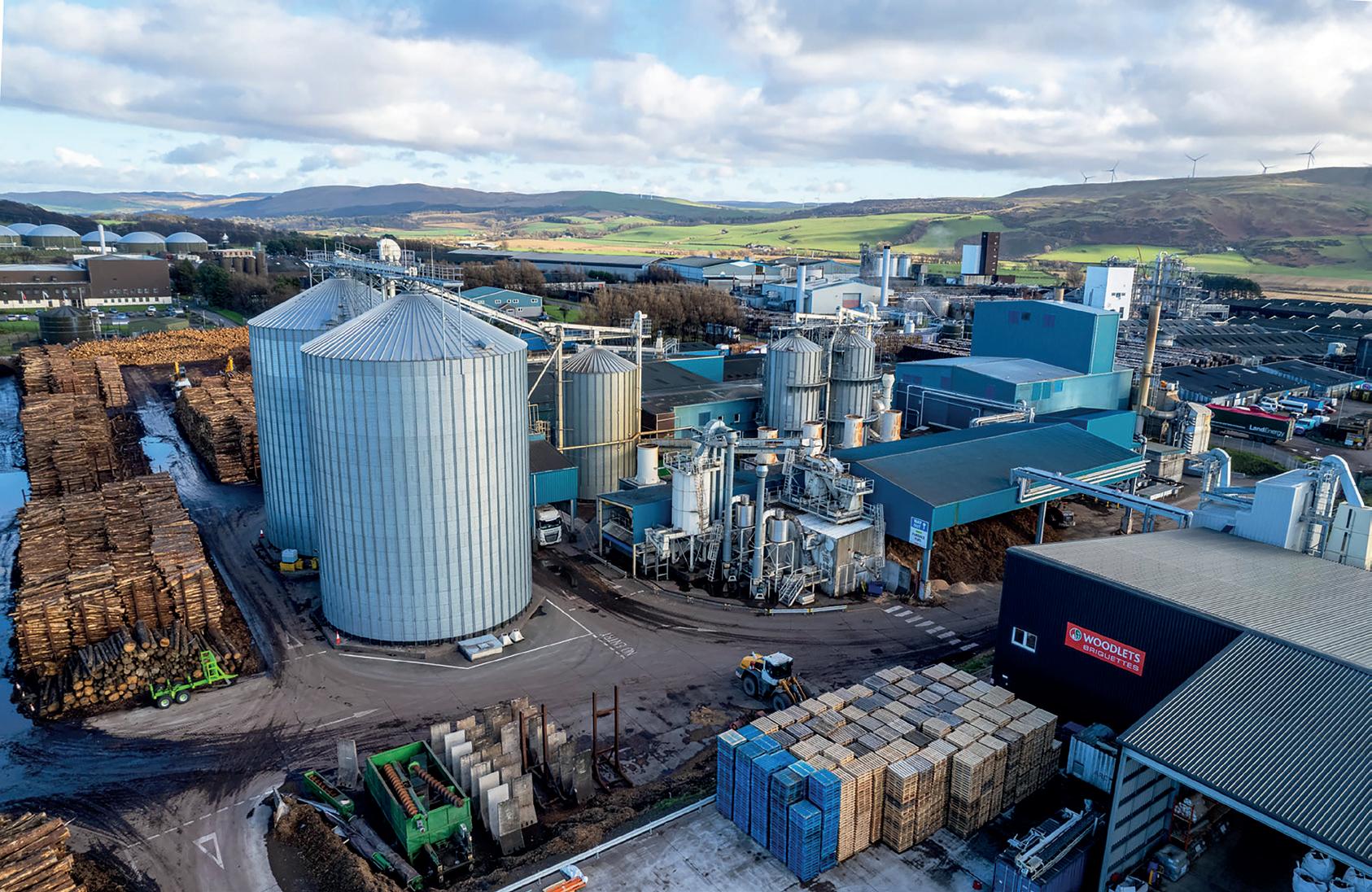
its woody biomass feedstock is sourced from forests within a 60-mile radius of its factory in southwest Scotland. This supply chain ensures continuous manufacture at a time when imported supplies cannot be guaranteed.
The business also produces its own power, generating a massive 18.2 GWh pa using its own biomass boilers - the equivalent to providing 6,750 homes with heat for a whole year.
There is no such thing as a ‘squeaky clean’ energy source: all forms of renewable energy technology carry a carbon debt - including wind turbines, solar panels and electric cars. However, biomass production in the UK is sustainable and biodiverse. It has short, secure supply chains coupled with a highly efficient production process to make solid, energy-dense, biomass fuels.
Small-scale, localised biomass boilers producing heat are about 85% efficient.
Using locally grown, locally harvested wood and generating heat and power from brash left on the forest floor is the most efficient and economic use of a sustainable local resource.

The need for taking immediate, bold action on climate change is being increasingly recognised by businesses, government and the general population.
Land Energy has acknowledged this need to act and decided to explore its own carbon emission output in order to prove how they out-perform their competitors. This scientific research directly influences the growth of the forest industry.
Leading carbon solutions company Auditel* conducted a comprehensive, independent ‘Scope 1-3’ report on Land Energy to check the carbon footprint of the company’s production and delivery processes.
Auditel’s robust report looks at Land Energy’s emissions from the moment a tree is planted to when a customer uses its products to heat their homes. The finished report follows strict International Organisation for Standardisation (ISO) 14064-3 rules.
The ISO rules make fair comparisons between different companies. Without these

rules, any claims about being eco-friendly are not necessarily reliable. This is the first time any wood pellet and wood briquette producer has created such a report on a comparable global scale.
Auditel’s independent report gives a clear objective view of biomass as an energy source and explains three main areas:
• SCOPE 1: Direct emissions from Land Energy’s own factory and sites - not counting energy they get from outside sources.
• SCOPE 2: This includes all the energy Land Energy uses, both on-site and off-site
- for example, electricity from the grid.
• SCOPE 3: This covers all carbon emissions made by third parties in connection with operational activities - that’s everything from sourcing from the forest floor and the production process to end-user products delivered to customers doors’. This is the largest part of a company’s carbon emissions.
Emissions are measured in terms of how much CO2 is released for every unit of energy delivered.
continued from p45
final findings
According to the report, Land Energy’s wood pellets and briquettes, made and sourced here in the UK, are far better for the environment than those imported from other countries, releasing 45% less CO2 than the average imported product.
A short, sustainable supply chain - with minimal distances from forest sourcesand an efficient supply chain from factory to customers (an average of 200 miles) is why Land Energy has the lowest CO2 footprint in the business.
Biomass often receives bad press, but when fibre is sourced locally it is, in actual fact, 26-times better than oil - and this does not take into account the emitted flare gases that are released by major energy companies 24 hours a day.
Compared to using fossil fuels (gas or oil), Land Energy’s biomass energy is far better for the environment. Auditel’s report states that it is 70% better than gas and 95% better than oil when the entire process from planting trees to using their energy is considered.
The report also responds to concerns from groups such as Greenpeace about

how their activities affect the soil. Land Energy is working to minimise any negative impacts on issues such as peat bed disturbance.
But even Greenpeace admits: “Using mill waste and residue, such as sawdust and non-commercial wood chips, to replace fossil fuels for local, small-scale heating systems is the most efficient use of woody biomass” (Greenpeace - Fuelling a Biomess).
Key points
• Imported wood pellets have significantly higher emissions than Land Energy wood pellets.
• Heating oil has

than Land Energy wood pellets (7x mains gas).
• Land Energy wood pellets are 4x below the BSL standard threshold.
True, economically home-grown wood pellets are best for the UK market. The UK needs home-grown biomass energy if it is to reach its target of net zero carbon emissions by 2050.
Land Energy is keen for people to understand their efforts to be eco-friendlyand welcome any comments on the published report.
*Auditel is a leading cost, procurement and carbon solutions company which helps organisations reduce their carbon emissions.
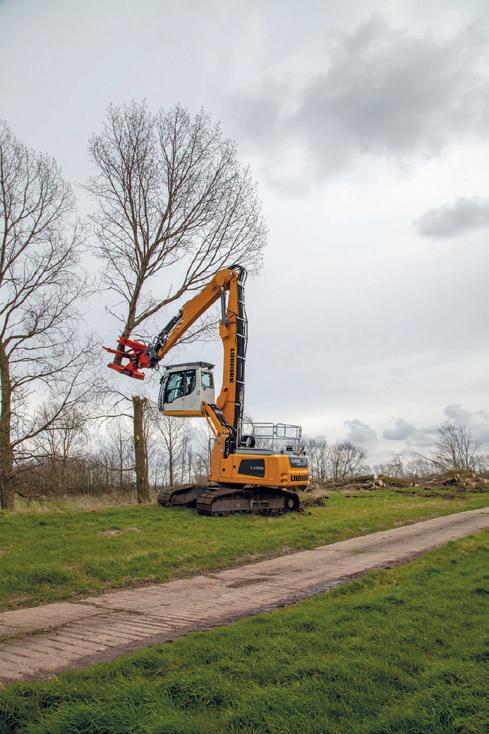








A unique ‘Woodland to Workshop’ course from the charity Woodland Heritage will bring together tree growers, wood users and beyond to learn how to make the most of the vital connections between our woodlands and workshops.
‘Woodland to Workshop’ has three key audiences. The first is growers such as woodland owners, foresters and nurseries. The second is processors and users of wood, such as makers, architects, artists, renovators and those in construction, hobbyists, millers, buyers, arborists and sustainability experts.
Finally, with woodlands and wood being so well loved the course also appeals to those in education, campaigners, scientists and those working in the public and third sectors.
This ground-breaking course is supported by knowledgeable practitioners from the forestry and timber industries and is based at The Duchy of Cornwall’s woodland, Whitney Sawmills and at the New Model Institute for Technology and Engineering (NMITE), all in Herefordshire.
Kester Hoefkens is a trained cabinet maker and furniture designer who manages Woodlab, a makers’ space and workshop focused on using locally grown sustainably sourced timber.
He attended the most recent course and said: “I loved the class introduction; breaking the ice and getting a broad view of what the attendees were about. It was great to see the different ends of the industry come together.
“The Duchy’s woodlands at Shenmore
was a great day; the insights on the woodland were top notch and the amount of information passed on was mind blowing!”
Attendee numbers are restricted to enable a ‘hands on’ and highly interactive approach, ensuring a learning opportunity of enduring quality that has been enjoyed by hundreds of passionate people over the years.
NMITE, which already has a strong reputation in the timber industry through its Timber Technology Engineering Design (TED) courses, was delighted to partner with Woodland Heritage in 2023 and is looking to replicate its teaching success again in 2024.
Describing this as a perfect partnership “where Woodland Heritage’s remit finishes, NMITE’s teaching takes over”, NMITE Assistant Professor Steve Bertasso added: “Timber and woodlands need to sit at the centre of sustainable solutions now and in the future.
“The built environment is the world’s largest producer and consumer of greenhouse gas emissions. Creating solutions through and from natural, renewable sources, like timber, produces fewer emissions than other building materials. The new partnership between Woodland Heritage and NMITE brings together the two ends of a circular
building industry.”
Geraint Richards, Head Forester to the Duchy of Cornwall and to His Majesty The King, and Woodland to Workshop Course founder said: “I have been teaching on Woodland Heritage’s wonderful Woodland to Workshop courses since they began. The fact that the attendees are drawn from a wide variety of backgrounds makes the discussions so varied and stimulating.
“It’s vital that we increase the understanding around the management of our trees and woodlands and the use of the products we can derive from them and the Woodland to Workshop courses are an exciting means of helping achieve this.”
Woodland Heritage is a charity creating a thriving UK wood culture that benefits our environment, all people and our economy. It champions the good use of home-grown timber from sustainable, productive woodlands for the benefit of present and future generations.
Through a combination of demonstration sites, research, education, membership and outreach, the charity builds on the wisdom and skills of the past to weather the challenges of tomorrow.
The next course will run from 24 to 26 September 2024. Booking and pricing information is available at www. woodlandheritage.org/woodland-toworkshop.







Considering the market influences on the first half of the year, Mike Tustin shares an outlook on the coming months with new forestry properties hitting the market.
The first half of this year has seen the market in England and Wales rebound quite convincingly after a quietish 2023 characterised by slow interest and low numbers of properties being offered. This is the chicken and the egg conundrum - does the low number of properties on the market cause low interest or does low interest deter people from marketing their properties?
The forestry sector can agree that last year saw a decline in values probably due in part to high interest rates and a timber sector that was generally down in price.
Today, after a few property launches in the early part of the year, we are happily seeing a steady improvement in the number of telephone calls from genuinely interested parties. Along with this, we have also seen a large increase in the number of people thinking about marketing their properties.
Will the supply bring people out into the market, or will it lower prices? The next edition of FTN in early Autumn may well have the answer.
Timber prices seem to have a more positive outlook than previously. As always, with everyone holding their breath as the first few timber sales of the new season take place, we have seen a slightly more positive outcome from those who took the plunge and got onto the open market quickly.
Ffynnon Badarn
Some very healthy prices are being offered to tempt reluctant owners to open the gates and keep the wood flowing. In England and Wales this is probably partly down to NRW offering mainly hard and slow to work thinnings in its annual round of timber sales despite promising a similar quantum and quality of output as last year. Apparently, this has come about as a result of a drive to save on replanting costs after the Welsh Assembly ran out of money.
Timber buyers are therefore looking at the private sector to help make life a little easier but, as we all know, tempting woodland owners to sell timber requires a buoyancy in the market which has not been there in recent months.
Lower inflation helps the forestry sector as the cost of running sawmills and processing machines stops increasing so rapidly and buyers can afford to offer slightly better prices without worrying about unforeseen price rises when they start to process the wood.
Regarding interest rates, whilst the Bank of England stubbornly refuses to reduce these at the present time, it does appear to have a clear path to reduction with monthon-month reports of lower inflation. We will all likely be relieved to hear the BoE chiefs agree there should be a decrease in rates after a monetary policy meeting in the near future.
Even a small one will create a positive feeling in the money markets. Cheaper borrowing, whilst not normally used for buying woodland, paves the way for an increase in the number of people who wish to invest in the woodland enterprise they have always wanted.
Interestingly, our phones became busier the day after the BoE stopped increasing interest rates in September 2023 as people obviously breathed a sigh of relief.
In the southern half of the UK, more particularly in Wales, the new spring season started very positively with the marketing of Ffynnon Badarn by Tustins. At 480 hectares this is probably going to be the largest forest that will be marketed in Wales this year. Further, it may have been the last of the really large 1970s afforestation projects to pass out of the original family’s hands.
At closing date, a positive offer was accepted by the owners following a very exciting period of marketing that saw a good number of people returning to the market who had been absent for almost 18 months.
At the same time other properties, such as the adjoining Bedstone and Bucknell (126 and 49 acres respectively) in the borders of England/Wales which had been on the market since late 2023, also changed status to sale agreed.
continued on p50

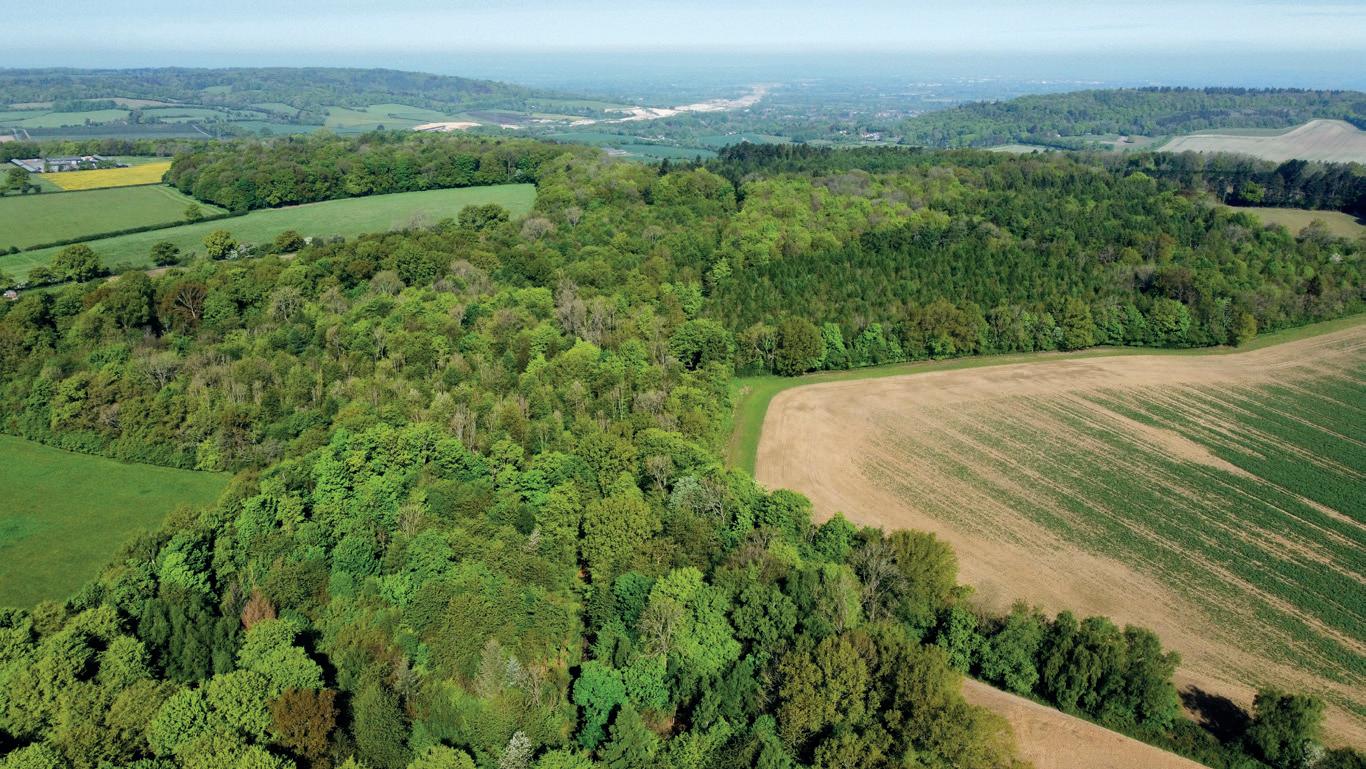
continued from p49
As always, the regular listings of smaller, less than 40-hectare properties, created a solid backdrop to proceedings in the first quarter with a number of smaller, less commercial offerings selling remarkably well after only a few weeks of marketing. For us, this flurry of activity translated into multiple bids and generally very happy vendors.
In a similar vein, John Clegg and Co marketed Coed Pen y Gelli in Flintshire. This attracted a number of bidders and an early offer for 70 acres of leasehold machine harvestable and easily accessible Beech firewood.
This early in the season it is still quite difficult to see where the market is really heading this year as this is traditionally the part of the year where the majority of the properties come on the market. As a result, we probably need to list a number of new instructions that are coming or already on the market at the time of writing.
Esgair y Fford near Machynlleth, a 100ha upland commercial woodland guided at £1.5m, has made a public appearance after a period of being offered off-market by Goldcrest. Also available from the same agent a 40.99ha riverside native plantation known as Dolgarrog with 11,858 PIUs included. This unusual offering will educate all who advise clients on the values of PIUs and a more conservation focused stocking.
Tustins has just launched Concord and Lordling Woods, a large woodland package situated in the Chilterns. These are 140 and 28 acres respectively with guide prices at £700K and £225K. Unusually, both of these woods have a commercial native broadleaved slant and as a result we expect local interest to be strong.
In this region we are finding that woodlands that are able to turn a profit for the owner are very well received by bidders and we hope that this will work out for this offering.
Another large offering is Harrison (Haugham & Burwell) Woodlands, 195.6ha of mixed conifers and broadleaves situated in North Lincolnshire and on the market with a guide price of £3,000,000.
Those who look at the smaller end of the market should be encouraged by the launch and agreed sale of Faulds Spring Wood. This small Sitka spruce plantation emerged onto the market just a week before writing this note. A sale was agreed just a few days ago with
substantial interest. This type of woodland always sells well but the competition that appeared in just one week was exceptional.
Another strong indication of how the market is doing is when you hear of some off-market deals that have taken place largely due to the buyers not wanting to compete against others on the open market. We have been involved in two recent deals which have shown a positivity not seen since late 2022.
What are we learning from all this? It’s simple, especially if the woodland is commercial in nature. The market is generally good but beware if you are tempted to over price something.
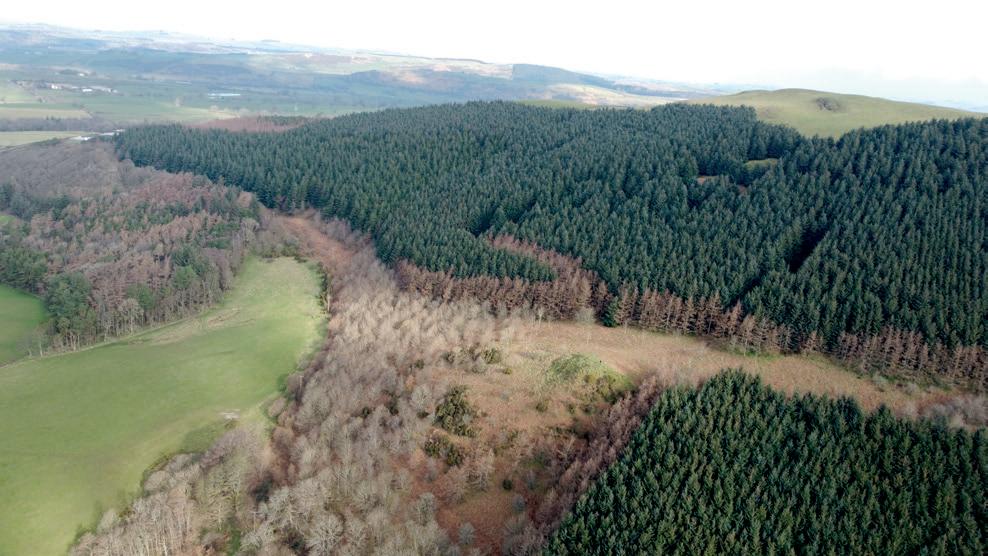


Experience unprecedented performance with STIHL‘s extensive range of professional grade battery-powered tools for commercial users.
IPX4 certification lets you continue working with confidence in the rain. Long-lasting smart batteries deliver consistent power throughout the whole battery charge. And fast chargers deliver quick recharge times so you and your tools are always ready for the job.



Kate Donachie and Abigail Cadden of Brodies LLP detail the different obligations imposed by the type of insurance policy covering your business activities.
When you take out an insurance policy, your insurer generally agrees to indemnify you in specific circumstances, but it’s important to remember that the obligations are not one-way. To ensure cover is provided, you must also do certain things. If you fail to, you might find yourself without the cover you have paid for and relied upon.
Insurance policies and the obligations imposed by them vary, but there are some conditions that are commonly included and one of the main ones is the duty to notify your insurer.
Most employer and public liability policies require you to notify the insurer of claims or potential claims within a certain time period. A failure to do so can result in your insurer refusing cover.
It is important to read and understand when you are obliged to make a notification. Some policies require notification as soon as you are aware of circumstances which could give claim. This means that if you claim is intimated, or a court you may be too late and you covered.
There are two main ways be provided by policies; ‘claims ‘loss occurring’.
• ‘Claims made’ policies provide for claims made within the period policy, regardless of the date • ‘Loss occurring’ policies provide for losses which occur during of the policy, even if the policy by the point the claim is brought.
The notification requirements types of policies can differ.
‘Claims made’ policies require notify the insurer, before the of any circumstances that have occurred and which may give a claim, even if there has not any indication that a claim will A failure to notify the insurer circumstances is likely to lead being refused for claims that those events.
As ‘loss occurring’ policies cover for events that happen course of the policy, notification events is not usually required. the policy is likely to require events during the policy period possible and, in any event, before of the policy period.
Insurance policies also generally oblige policyholders to notify the insurer if there are any material changes to the risks which are insured.
A change in the type or location of work being carried out, or an increase in annual turnover are examples of changes that insurers routinely class as material, and which require notification.
If you are making any changes to the way your business operates, you should check whether you need to notify your insurer.
The key thing is to understand your obligations in an insurance agreement, so that you can make sure you do what you are obliged to do, and your insurer is, in turn obliged to provide cover.
Kate Donachie is a legal director and Abigail Cadden is a senior solicitor at Brodies LLP, specialising in insurance matters.
Confor Members have access to a free legal helpline, administered by Brodies LLP. Get in touch for guidance on key issues that impact forest owners and the forestry sector.
Whether your query is employment law, health & safety, planning, tax or propertyrelated, one of our experts will be happy to give you a free initial consultation. More info: https://bit.ly/3yPGRI1
For members based anywhere in the UK Brodies LLP 0131 228 3777 www.brodies.com confor@brodies.com
For members based in England/Wales Atkinson Ritson Solicitors 01228 525221 www.atkinsonritson.co.uk info@atkinsonritson.co.uk





model, the Touareg, to see how the latest version performs. Touareg and makes it look like an Audi Q8 from the rear. The front head lights feature new all-powerful LED units too. There is a new design steering wheel and updated satnav screens. The seats are very comfortable, and the brakes are good too.
The Touareg was once a common sight on UK roads when SUVs were at their height of popularity.
These days, it’s a slow seller even if it is Volkswagen’s top model. This revised model still uses the Mark 3‘s body, but with refreshed exterior lighting and a wider range of engines.
On offer are two diesels, one petrol, and two plug-in hybrid petrols. Prices start at £67,780 for the V6 231bhp diesel, £70,660 for the 286bhp diesel, and from £69,150 for the hybrids. All have four-wheel drive and the diesels have air suspension.
The basic chassis is shared with the Audi Q7/Q8, Porsche Cayenne and Bentley Bentayga. It drives very well and is a very comfortable car. The diesels return 34mpg and weigh 2,118kg. It can tow a 3,500kg unbraked trailer. It is 4,902mm long, 1,695mm high and 1,984mm wide. The diesels are plenty fast enough, accelerating from 0-60mph in 6.4 and 7.7 seconds respectively.

The boot is large at 810 litres and expands to 1,800 litres with the rear seats folded down. The fuel tank holds 75 litres. The four-wheel drive 4MOTION system provides four-wheel drive with Torsen gearbox as standard, and self-locking central differential with asymmetrical dynamic drive. Off-road driving programme is activated by rotary switch.
On test we had a short spell off road
The self-levelling height-adjustable suspension provides for a nice comfortable ride and irons out potholes and road pumps very well indeed. It includes Normal, Comfort, Off-Road and Special Off-Road driving modes. Body control is tight, and the steering accurate and nicely weighted and responsive. The four-wheel steering reduces the turning circle and improves agility.
The car comes with a three-year or 60,000-mile warranty.
The Touareg is a good vehicle, but perhaps a bit too lacking in adventurous styling whilst coming with a fairly high price. Mind you, most cars are getting expensive these days. Another comfortable, capable and competent VW.
Eamonn Wall BSc MSc FICFor is Managing Director of Eamonn Wall & Co Woodland Design and Tree Management.
Contra House officially opened its doors in April after plans were first unveiled for the HQ site in 2022.
Opening ceremony photo caption: (LtR) Kay Green, Managing Director of STIHL GB, Dr. Nikolas Stihl, Chairman of the STIHL Group Supervisory Board, Sarah Gewert, Executive Board Member for Marketing and Sales, Councillor Pat Tedder, Mayor of Surrey Heath.
STIHL GB has announced the opening of its new, purpose-built head office and distribution centre, Contra House, ushering in a new chapter for the business.
Dr Nikolas Stihl, Chairman of the Supervisory Board of the STIHL Group, presided over the opening ceremony, marking a milestone in the machinery company’s history.
Named Contra House in homage to the iconic STIHL Contra chainsaw, invented by founder Andreas Stihl, the 11,500m2 facility reflects STIHL GB’s dedication to providing unparalleled support to its dealers and end users.
Home to more than 100 staff, Contra House is designed to enhance operational efficiency, customer service and employee well-being.
The building of the facility was undertaken by Glencar Construction. When announcing the plans for the new building in 2022, Stihl GB committed to three native planting schemes in the local area to replace the greenery removed during construction, as well as adding an


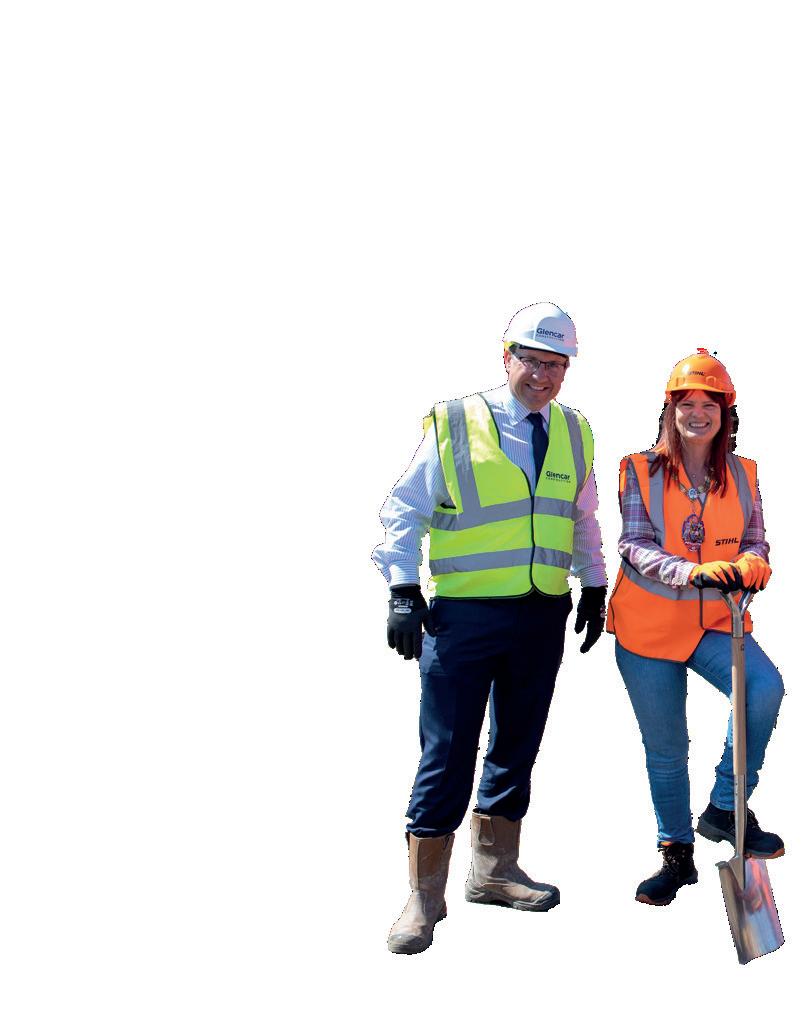
additional 10% of planting provision.
The new site features dealer training facilities and a studio, collaborative workspaces, an on-site restaurant, and a technical workshop, ensuring support for STIHL GB’s 700-strong approved dealer network.
At the heart of the operation lies the 9,000m2 distribution centre, which boasts next-generation picking and storage systems. This consolidation of logistics onto one site enables STIHL GB to streamline operations, resulting in a speedier and more efficient delivery service.
Kay
Green, Managing Director of STIHL
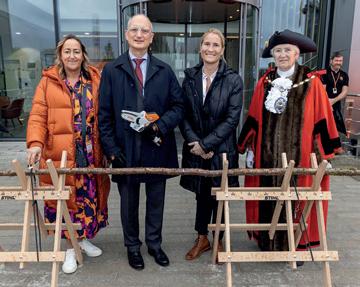
GB, said: “The unveiling of Contra House symbolises a significant step forward in our commitment to product innovation and providing exceptional service to our customers and dealer network.
“We are thrilled to unveil the new facility, which not only embodies our rich heritage but also stands as a testament to our vision for the future.”
Contra House distinguishes itself not only through its modern design and functionality but also to sustainability.
The facility has achieved BREEAM Certification, with features such as photovoltaic solar panels covering twothirds of its roof area and 21 electric vehicle charging points, aligning with STIHL GB’s commitment to responsible business practices.
The official opening event, attended by more than 160 guests, also outlined STIHL GB’s partnership with Perennial, the UK’s only charity dedicated to helping people in horticulture.
The STIHL team will volunteer in a wide range of fundraising activities to help the charity provide free and confidential advice, information and support to people working in, or retired from, horticulture and their families.


HGVC, a leading HGV training specialist, is helping 17 SME agriculture and forestry firms train existing employees as part of its majorityfunded Skills Bootcamps in HGV Driving scheme.
While haulage driver shortages continue to contribute to market headwinds in the sector, the Department for Education (DfE) funded Skills Bootcamps offer a lifeline for the agriculture and forestry firms.
Now, HGVC is helping 17 SME agriculture and forestry firms train new HGV drivers. Up to 1,900 places are available over the next two years and HGVC is encouraging more firms to apply while places remain.
The HGV Skills Bootcamps are flexible courses of up to 16 weeks, helping people build up sector-specific skills. First launched in December 2021, the DfE has extended the programme. For employers with fewer than 250 employees, the Skills Bootcamps are 90% funded by the DfE. Employers pay the remaining 10% of the course cost.
HGVC will focus on supporting employers looking to upskill existing staff via three pathways: helping novice drivers gain their Category C (rigid lorry) licence, a Category C+E (articulated lorry) licence, or helping those with a Category C licence upgrade to a Category C + E.
James Clifford, CEO of HGVC, said:
“Many agriculture and forestry firms still need more HGV drivers. We are now helping 17 agriculture and forestry firms train existing employees. But we have the capacity to train more. That’s why we’re encouraging SMEs to apply for the HGV Skills Bootcamps scheme, 90% funded by the DfE.
“For employers considering training budgets, this is a great opportunity to train existing staff. With this funding, we can get even more drivers behind the wheel and keep Britain moving.”
Kim Parsons, Managing Director, Agreco, commented: “At Agreco, a reliable supply of qualified HGV drivers is essential for our efficient forestry operations. The Skills Bootcamp program, with its generous 90% funding, has been a valuable initiative.
“By investing in training our current workforce to become HGV certified, we can ensure timely deliveries of timber to our customers. The streamlined process offered by HGVC makes everything very manageable. We expect to have our new drivers on the road, supporting our forestry operations, very soon.”
HGVC’s scheme is open to any agriculture and forestry firm looking to upskill their existing staff. The training courses are available at 60 locations across the country. Employers can apply at www. hgvc.co.uk/bootcamp.
As part of their annual review of industry and waste, the Climate Change Advisory Council (CCAC) has called the need for sustainable construction methods ‘critical’ for reducing industrial emissions.
Marie Donnelly, Chair of the Climate Change Advisory Council said: “One of the primary sources of industrial emissions is cement production. We must address this now, by promoting more sustainable building methods including increasing the use of timber in construction and reducing emissions in the cement production process.
“Updates to the Building Regulations that support increased use of timber in construction should be consolidated with the establishment of a high-level cross departmental task force to prepare an overarching national strategy for the development and expansion of all aspects of the timber industry in Ireland.”
“Targets must be set and measures
introduced that support the reduction of emissions in cement production. The introduction of financial incentives to encourage retrofitting of existing buildings over demolition and rebuilding would also help reduce cement demand.”
The CCAC also highlighted that introducing whole-life carbon assessments and targets in the planning process for public buildings is required to help achieve the sectoral target.
In 2022, timber frame construction accounted for less than 25% of new homes built in Ireland, compared to over 70% in the developed world and 80% in Scotland.
David Murray, Head of Technical Affairs & Ireland Sales at MEDITE SMARTPLY, commented: “The Irish government’s Housing for All plan sets out ambitious housing aims in order to meet the increased demand for housing in Ireland by 2030.
“In light of the progress seen in the construction sector, timber
frame construction presents a viable option for fulfilling the government’s ambitions. Since it can be completed much faster than other methods, timber frame construction can help meet the time constraints of the government’s construction targets.
“Furthermore, the Climate Change Advisory Council has made a pressing call to increase the use of timber in the construction of new builds in Ireland, recognising timber’s vast potential as an environmentally savvy construction method. Trees absorb atmospheric carbon as they grow, and using timber products in construction effectively stores that carbon within the building structure for its lifespan, as well as in any recycled wood products made from the original material. This reduces a building’s overall carbon footprint – in fact, at the individual building level, carbon storage is approximately 50% higher in timberframed homes than in masonry homes.”
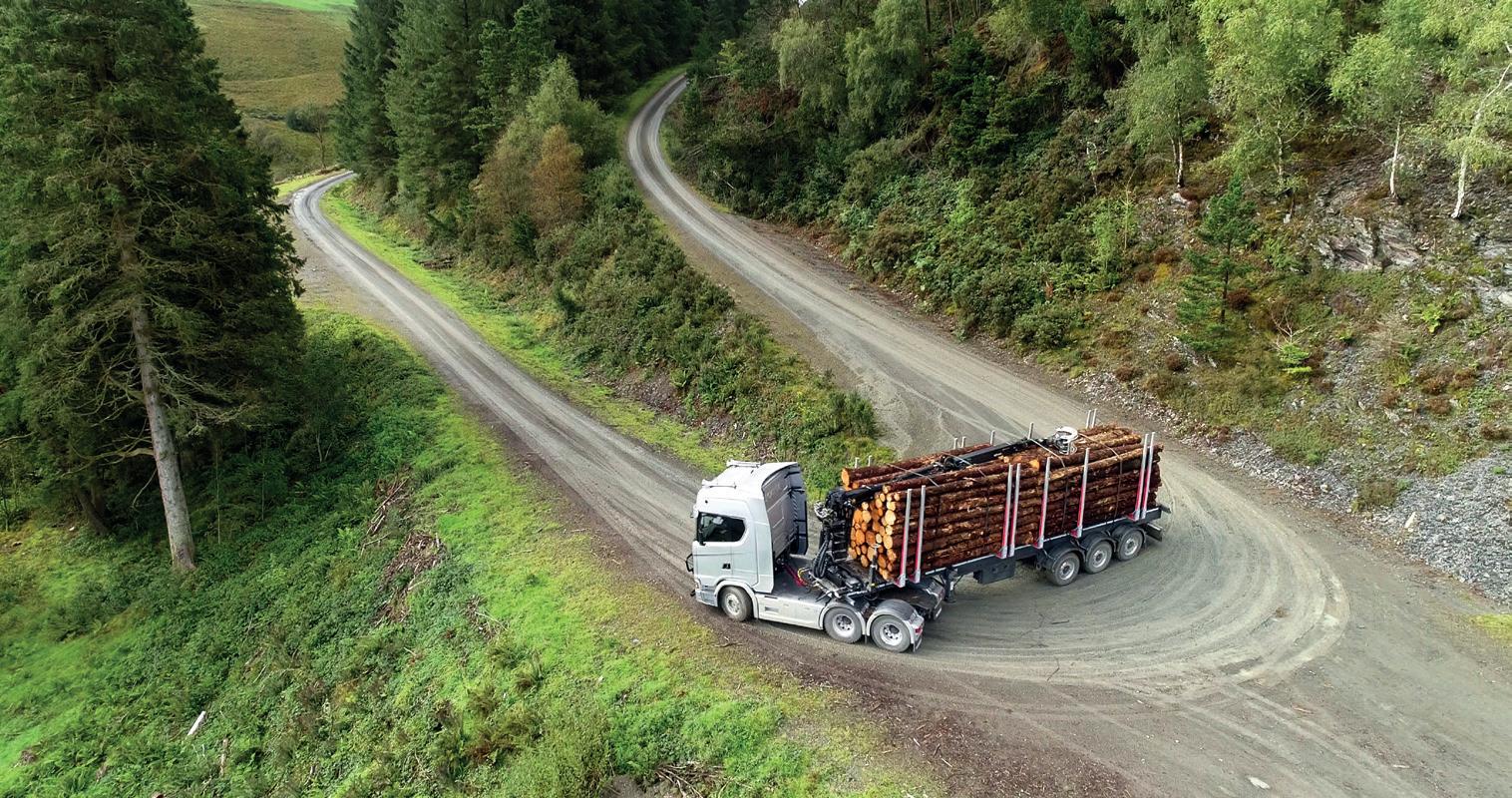
New projects which will help improve Scotland’s timber transport infrastructure, decarbonise the forestry sector and take pressure off rural roads used by communities have been given a funding boost.
Timber transport projects in Argyllshire, Perthshire, Dumfries & Galloway, Scottish Borders, Ayrshire and the Highlands will share in £4 million of new funding from the Strategic Timber Transport Fund (STTF).
The projects will create new haulage routes away from busy villages, build passing places on narrow roads, upgrade existing fragile roads and promote the shipping of timber by sea.
Announcing the funding in June, Rural Affairs Secretary Mairi Gougeon said: “Our forestry sector has an important part to play in reaching Net Zero. I am pleased that the Scottish Government and local authorities are continuing to provide support to help the industry decarbonise, whilst also improving local transport networks. That is good for our forestry industry, strengthening its ability to get timber to market.
“But it is also good news for rural communities which are regularly affected by timber wagons using their same routes that local people use too. With road widening works, diversionary roads and more passing places, communities will be less affected.”
Scotland’s forestry sector is a major driver in economic terms, supporting around 25,000 jobs and generating over £1 billion to the economy each year.
Around 7 million tonnes of timber is transported from Scotland’s forests to sawmills and processing plants. The funding support assists the industry find ways to manage this effectively, whilst minimising the effects on communities.
The Strategic Timber Transport Fund, which is part funded by Transport Scotland, is managed by Scottish Forestry.

Some of the projects which feature in this year’s funding round include:
• £945,000 of support for the TimberLINK service which is enabling around 70,000 tonnes of timber each year to be moved by sea on the West Coast of Scotland.
• £284,500 is going to Perth & Kinross Council to improve parts of the A93 and enable the movement 280,000 tonnes of timber, including from areas toppled by Storm Arwen. The road is currently well used by local communities and tourists.
• £222,000 to Dumfries & Galloway Council to improve a stretch of the
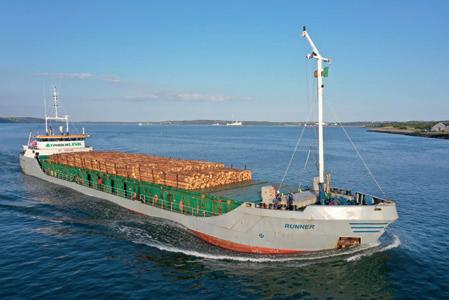
A711 through Dalbeattie which needs strengthened to carry an estimated 1,800,000 tonnes of timber over the next 10 years.
• Highland Council is to receive £245,000 to widen the approach to the Howford Bridge across the River Nairn on a route well-used by timber lorries bringing logs to the Gordon Timber sawmill in Nairn.
• £111,000 will go to Argyll & Bute Council for the continuation of improvement work on the road between Ballochandrain and Tighnabruaich through resurfacing and widening. This road serves a busy community and is forecast to carry 253,940 tonnes of timber over the next decade - typically going to onwards transport by boat from Sandbank.
Over the last 23 years, the STTF has contributed over £82 million towards improving Scotland’s timber transport infrastructure through 398 separate projects.
Overall, and considering the co-funded value through partnerships, the STTF leveraged a further £55 million to realise a total spend of £137 million.
The fund also supports a network of regional timber transport officers and a national co-ordinator who all work to help forestry stakeholders identify local timber transport issues and seek solutions.


Major milestone heralds significant shift towards circular economics in distribution of building materials.
In a world first for construction – and marking a fundamental shift towards circular economics in the transportation of building materials in the UK – the first batch of reusable green, RFID-tagged pallets from The Pallet LOOP, part of the BSW Group, have started entering the construction supply chain en masse.
Over the last three weeks, The Pallet LOOP and its manufacturing partner Scott Pallets have shipped more than 30,000 LOOP pallets to British Gypsum’s bagged plaster plants at Barrow, East Leake and Kirkby Thore. These pallets are now being processed through British Gypsum’s plants, with the first pallets already starting to arrive at construction projects, building sites, merchant yards and distribution centres nationwide.
Equipping each of its pallets with a radio frequency identification (RFID) tag, containing a small microchip, will give The Pallet LOOP the ability to scan pallets in and out of its production and collection sites nationwide. For The Pallet LOOP, this
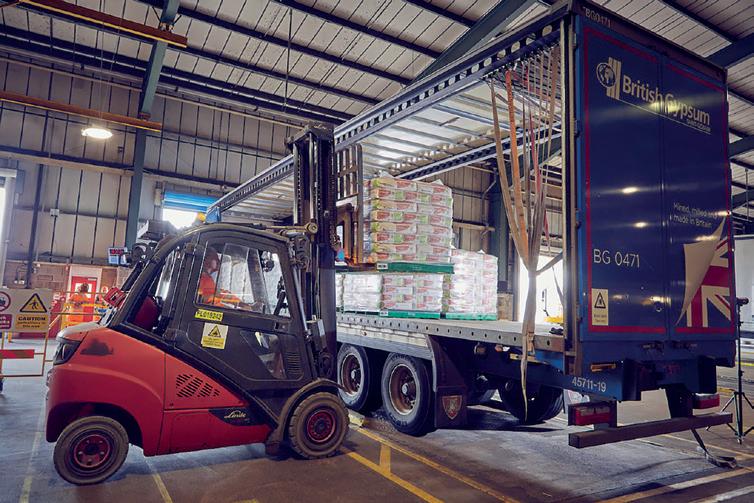
investment will give the business accurate, up to date information about the number of pallets issued to customers and, more importantly, collection and recovery rates.
Crucially, for users of The Pallet LOOP, the information will also prove invaluable; revealing fascinating insights about the financial and carbon savings they are achieving. Long-term, all building products users through the construction supply chain could access information about pallet and associated product dwell times, setting them on a course to achieving greater efficiencies.
This major milestone is set to shift the dial on pallet waste across the UK. As part of its offer, The Pallet LOOP will pick up green pallets across the UK, inspect and repair them where necessary, and redistribute them to building material manufacturers for the distribution of more products.
The roll out of The Pallet LOOP is also designed to support the construction sector’s net zero ambitions. Plus, in a further financial boost for the construction industry, The Pallet LOOP will also be paying registered return partners up to £4 back for every green pallet they put back in the LOOP – a figure that will quickly stack up as more pallets come online.
The Pallet LOOP can also pick up socalled ‘white’ pallets, as part of a holistic pallet collection service.
Paul Lewis, Founder of The Pallet LOOP, said: “If your business hasn’t already signed up for LOOP collections, now is the time to do so. Our distinctive green, reusable pallets are now winging their way across the country, and we want recipients to be ready to send them back to us. Since British Gypsum announced it was going to be the first user of The Pallet LOOP, we’ve had a great reaction from the sector.
“Lots of builders’ merchants, housebuilding companies and principal contractors are already signed up for collections – but we want to spread the word further, so all potential recipients know what to do with LOOP pallets when they arrive at their branches and sites.
“Over the next 12 months, we’ll be supplying British Gypsum with more than a million of our circular economy pallets for the distribution of its bagged plaster and plasterboard products – so if you receive these products, it is important that you sign up and get in the LOOP as soon as possible.”

Once companies are set up, arranging collections of both green and white pallets is simple, with two service levels available: a standard ten-day or a rapid 72-hour pick up service. Users of The Pallet LOOP will also receive access to a special reporting platform, where they can view and download information about the number of pallets returned and the money saved on collections versus disposal via a skip. The system also provides information about the amount of carbon saved and trees repurposed, which can be used in sustainability reporting.
The Pallet LOOP has a dedicated recovery infrastructure and a comprehensive network of collection hubs in place – enabled through its partnership with Scott Pallets, which is also part of BSW Group.
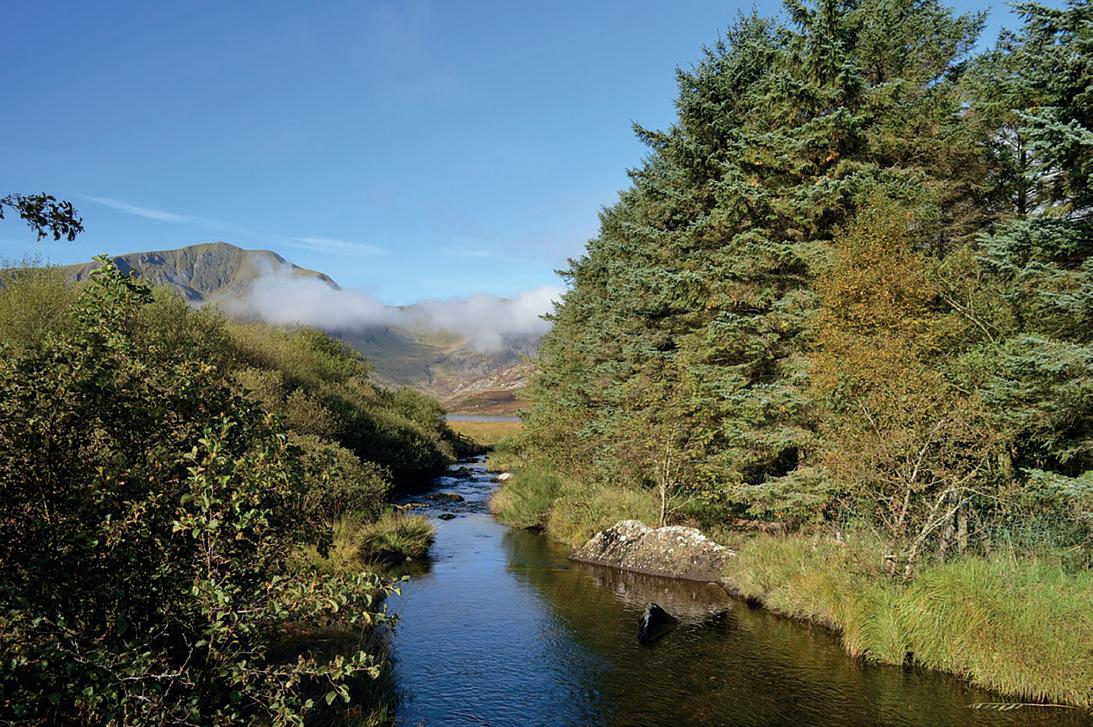
On 2 July, Huw Irranca-Davies MS, the newly-appointed Cabinet Secretary for Climate Change & Rural Affairs, will present to participants from across the wood value chain at WoodBUILD 2024.
Hosted by Woodknowledge Wales, this year’s conference will be held in at the University of Wales Trinity Saint David IQ Building in Swansea from 2-3 July.

“I’m delighted that the new The Cabinet Secretary for Climate Change & Rural Affairs will be making the keynote address on day one of our conference,” said Gary Newman, CEO, Woodknowledge Wales. “Now with responsibility for both the Sustainable Farming Scheme proposals and the emerging Timber Industrial Strategy, his perspective should be of huge interest to our network, from forestry through to timber construction.

King, CEO, Built by Nature, an industry leader debate on how to create more resilient wood value chains, an update from Welsh Government on progress Wales’ first Timber Industrial Strategy, two book launches, and host of useful and insightful workshops, demonstrations, immersive experiences and exhibits.
In the Cabinet Secretary’s recent statement on the Future of Farming in Wales, published on 14 May 2024, he wrote that the Welsh Government, working with Farming Connect, will “continue to promote the benefits and opportunities of tree cover and woodland on farms and work on knowledge transfer” and delayed the transition from the Basic Payment Scheme to the Sustainable Farming Scheme (SFS) until 2026.
brings together wood value chain stakeholders to discuss progress and consider next best steps towards an economic and environmentally beneficial forest industry for Wales.
Woodknowledge Wales stakeholders include land users who plant trees, all the way through primary and secondary processors and timber product and timber frame manufacturers, to representatives from the built environment sector who build with timber. These include professionals focused on designing, manufacturing and building homes using both traditional and innovative construction models and social housing developers responsible for commissioning Welsh homes.
This year, the conference will also include a day two keynote presentation from Paul King, CEO of Built by Nature, a network and grant-making fund dedicated to accelerating the timber building transformation in Europe.
“WoodBUILD, since its inception in 2016, has always been well supported by Welsh Government with past Ministerial addresses from Julie James MS, Cabinet Secretary for Housing, Local Government and Planning, in her previous roles as Housing Minister and then as Minister for Climate Change.”
In addition to the Ministerial address, WoodBUILD participants can look forward to a keynote speech from Paul
Woodknowledge Wales works across the wood value chain with a mission to purposefully develop the Welsh forestry industry from tree to product to benefit the economy, the environment and the people of Wales. Well-considered land use, and co-operation between farmers and foresters, is essential to this mission.
The WoodBUILD conference and expo
Home Grown Homes project (HGH) is a key project for Woodknowledge Wales. Supported by Welsh Government, one of the current phase two project tasks focuses on assisting in the development of the emerging Timber Industrial Strategy
WoodBUILD 2024 participants can therefore also look forward to an update on the progress of the Strategy.
Confor’s thoughts and condolences are with the friends and family of William L ‘Bill’ Mason, who passed suddenly in early June. The following words have been shared by Professor Chris Quine, Chief Scientist at Forest Research.
The sudden death of Bill Mason in Edinburgh on 8 June has left a large gap in UK forestry and in the lives of friends, colleagues, and family.
Over a long and productive career at Forest Research, Bill helped shape the course of upland silviculture, promoted rigorous applied field research, and enhanced the skills of many forest practitioners and scientists. In retirement, he continued to publish across a range of topical silvicultural issues as a research fellow of FR and share his expertise in meetings and field visits, most recently as Chair of the Continuous Cover Forestry Group.
After roles in forest management
in Suffolk and Lockerbie, Bill joined Forest Research at NRS in 1982 to take on the role of silviculturist with a particular focus on forest nurseries and plant establishment. He subsequently broadened his areas of expertise and developed a career as senior research leader (heading various periods of reorganisation) growing and sustaining international reputation FR’s principal silviculturist for upland forests. He contributed to many influential Forestry Commission and Forest Research publications, notably on continuous cover forestry, species mixtures and species choice – often well ahead of them becoming identified mainstream topics for sector Bill encouraged a rigorous collaborative approach to research and led much of FR’s cooperation with foresters in Europe (and further afield –

including New Zealand, Chile and China) through funded programmes and informal networks. He published many papers in the scientific literature – and perhaps uniquely, was awarded prizes for best papers in each of the main UK forestry journals those of RFS, RSFS, and ICF. he has shared his many early career and contributed to mentoring and workshops on technical paper-writing. forestry network forestry research communities have been active in recent days with exchanges expressing sadness and shock at death, and with fond memories of the positive he had on many careers. Forest Research publishing a fuller obituary in to many, an esteemed colleague but above all a devoted husband, father and grandfather who will be sorely missed.


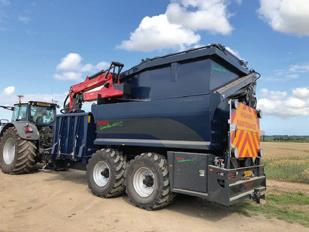
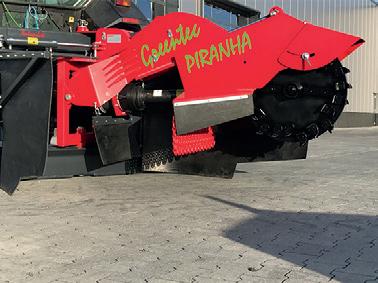
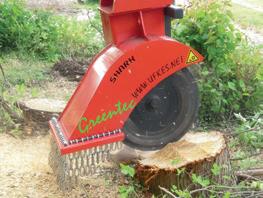
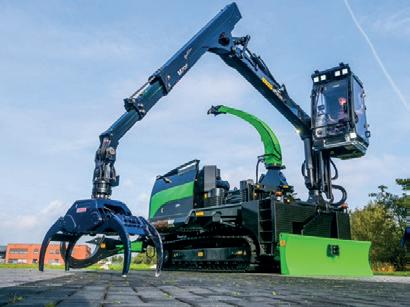


Professor Julian Evans OBE FICFor

Julian shares his experiences planting different species side-by-side and encourages other landowners to consider the benefits of a diversified woodland.
Every morning as I leave the house or look out of my study window I see a rare sub-tropical pine in the garden. It’s the species I have been working with investigating plantation sustainability in the Usutu Forest in eSwatini, Africa.
Pinus patula is an astonishingly successful tree in the cooler tropics and subtropics, but even in my garden at 15 years it has made 11.5 m height and 36 cm DBH. (It would have been several metres taller if a whirlwind hadn’t blown out the top four years ago!) But there’s something wrong: our garden is a frost hollow, and this tender exotic has not only survived but thrived. It even coped with the cold winters of 2009 and 2010 when newly planted.
So, should we be planting it along with countless other specimen species which are ‘doing well’ as individuals in tree collections and trials?
Resilience is the buzzword for building in some sort of diversity into our woodlands to help cope with future uncertainties including, of course, climate change. We looked at this topic in Woodland Owner three years ago and reminded ourselves that our palette of native species is small and exceedingly so for conifers; and it is conifers that supply what industry mostly demands, namely, softwood.
But resilience is not all about species diversity.
Uniformity in stands, while usually optimal for efficiency and economy, tends to increase exposure to risk from storms, drought and possibly pest and disease threats. Variety of sizes, ages and canopy layers both within and between stands all probably help mitigate risk, a bit like holding many kinds of shares rather than invested in just one company.
Continuous Cover Forestry (CCF) is one way to achieve this and the generally more open conditions around crowns of the biggest trees should reduce infections and may eventually lead to better wind stability. Such practices also modify the microclimate by ameliorating the extremes that clearfelling and replanting introduce.
The tool to diversify structure is, principally, thinning.
DIVERSIFY SPECIES
This issue is trickier than it seems. But without doubt not having all your eggs in one basket is prudent and why the
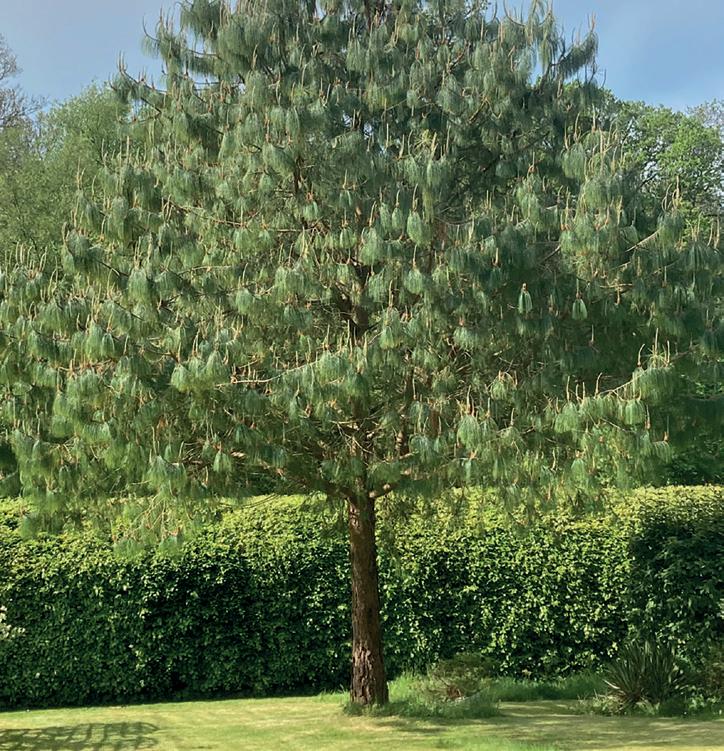
regulations about the proportion of a single species in new planting have been modified.
With broadleaves it is relatively easy to diversify by planting, clearing and thinning to ensure some spread of species even if your main crop is still focused, say, on oak. In 1987 I planted 1.4 ha (4 acres) of ash, wild cherry and oak in the ratio of 70:15:15. Today the ash are mostly dying or dead but the oak and cherry are thriving, supplemented by sycamore arising from natural regeneration (and some storing of coppice) which have helped infill for the lost ash. I still have three broadleaved species making up the stand.
Conifers are more problematic. In the lowlands mixtures with broadleaves within a stand is excellent silviculture such as oak:Norway spruce on heavy soils or beech:red cedar on calcareous ones.
In the uplands a good way is to diversify between rather than within stands, subcompartment by subcompartment. Forest Research’s recent work on
stand types and their Ecological Site Classification tool will suggest options. But what about unusual exotics such as the Pinus patula? Here I believe the small woodland owner must be both cautious – and await the many new trials investigating alternatives – and also less risk averse!
By the latter I mean that most small woodland owners will not be relying on their woods as a principal source of income so why not try something unusual? It may not be approved for grant aid purposes, but why not try something you’ve seen that’s promising? Back in 2009 I actually bought two patula pines, the one now in the garden and the other was planted in my wood. The latter didn’t last: deer found it, thrashed it and it was gone!
The purpose of this piece is to encourage us all to think about diversifying. And I haven’t even mentioned all the wildlife and conservation benefits that will arise too.







This photo was submitted by Mark Baker, Forestry Operations Manager at Christies of Fochabers. He captured this “moody” image of a tractor sat ready on the tree nursery while working at W. Crowder & Sons Ltd.
Want to see your picture here?
Forestry in Pictures is a regular feature in FTN. For every issue, we select the most impacting photograph sent by a reader. If you have a photo you would like to see published here, please send your file to ftn@confor.org.uk Please include your name, a short comment text to go with the picture, and an image credit.
Photos should relate to forestry and timber and be of high-quality (minimum resolution 300dpi). Exceptional pictures might be considered for the front cover of a future FTN issue. By submitting a picture to Forestry in Pictures you give Confor permission to use the file for non-commercial purposes in Forestry and Timber News or the Confor website. Photos will always be credited.
In August’s issue we will be previewing this year’s APF show and focusing on Machinery. Remember that FTN is your magazine – get in touch if you want to suggest editorial or give us feedback on articles we have published in the past. Confor members, send us your company’s news updates or pitches for feature articles.








